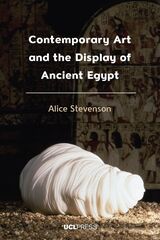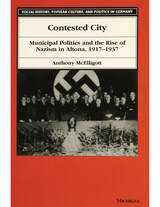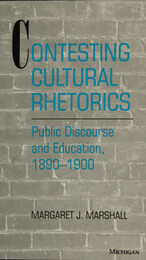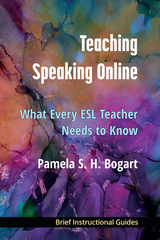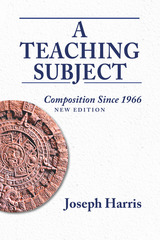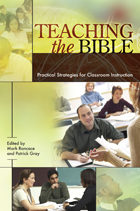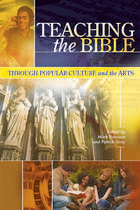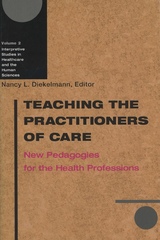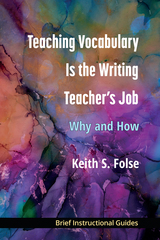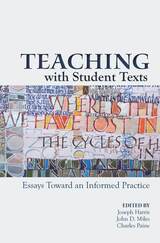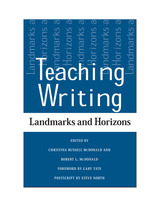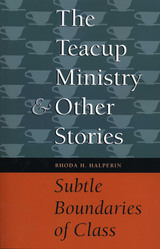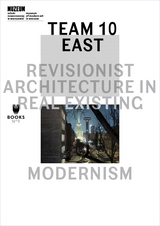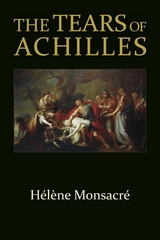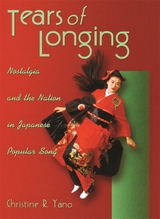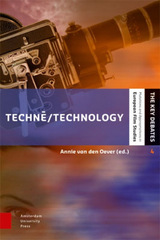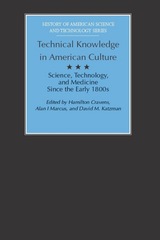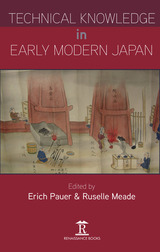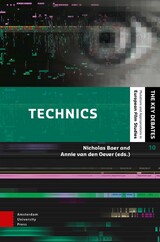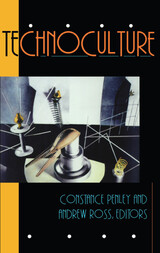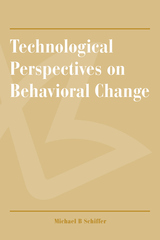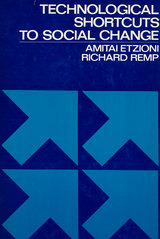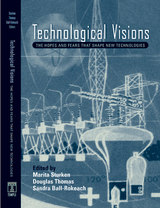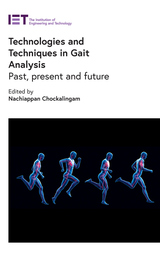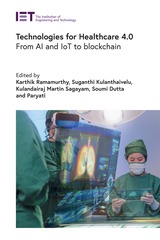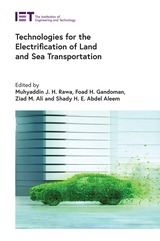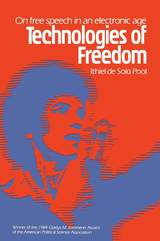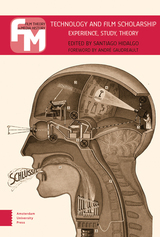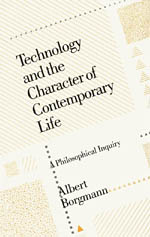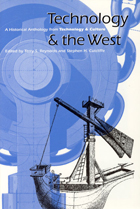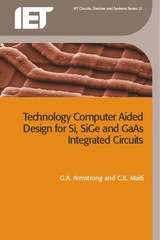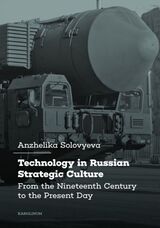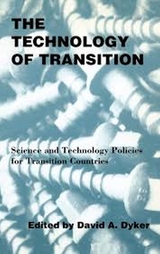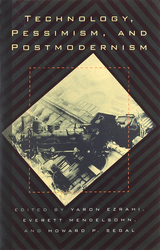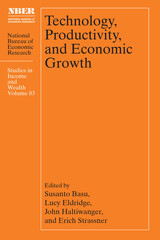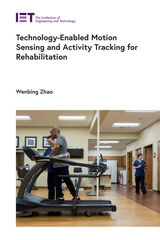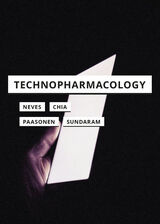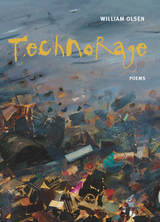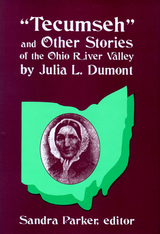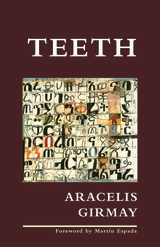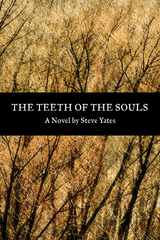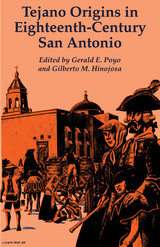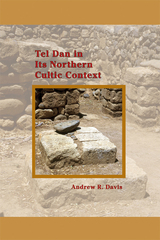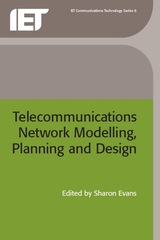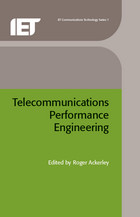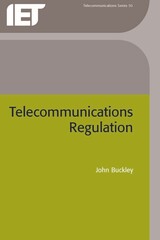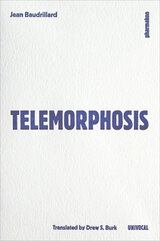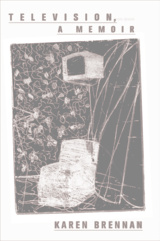 Teaching Service and Alternative Teacher Education: Notre Dame's Alliance for Catholic Education
Michael Pressley
University of Notre Dame Press, 2002 The Alliance for Catholic Education, referred to most commonly by its acronym ACE, is one of the best known and widely respected programs at the University of Notre Dame. The rock band U2 praised it during a concert at Notre Dame, the President of the United States acknowledged it in a valedictory address, and each year hundreds of students compete for admission. Established in 1994 by Fr. Timothy Scully, C.S.C., and Fr. Sean McGraw, C.S.C., ACE places more than 150 college graduates in over one hundred parochial schools throughout the United States. The overarching purpose of ACE is to improve Catholic schools, especially in underprivileged areas of the U.S., by enabling exceptionally talented students to teach in them. ACE, in turn, offers students two years of meaningful service and a graduate degree from Notre Dame.
In Teaching Service and Alternative Teacher Education: Notre Dame's Alliance for Catholic Education, Michael Pressley and his fellow contributors provide the history of ACE. They also offer a blueprint for other educational institutions interested in implementing a similar program. Covering the fundamentals of starting and maintaining a program like ACE, Teaching Service and Alternative Teacher Education discusses motivation, planning, intellectual foundations, and community building. It also tackles practical issues such as financing the program, obtaining accreditation, and recruiting teachers.
MICHAEL PRESSLEY is director of the Master of Education Program, professor of psychology, and Notre Dame Chair in Catholic Education at the University of Notre Dame. He is the author of numerous books and editor of the Journal of Educational Psychology.
"Teaching Service and Alternative Teacher Education is highly significant to scholars and students in related disciplines. It reports on a program that is likely to be used as a model for similar programs for years to come. This volume will be an important resource for anyone who is interested in alternative teacher education. Readers cannot fail to be impressed by the ACE program--and they will learn a lot about the design and development of quality alternative teacher education."
--Joanna Williams, Teachers College, Columbia University
"ACE is an innovative program and has a worthy story to tell. Teaching Service and Alternative Teacher Education makes a solid contribution to the fields of Catholic education and teacher education reform. It will be significant for educators interested in innovative approaches to the design of teacher preparation experiences."
--Jennifer Whitcomb, University of Denver
----------
"Philanthropists interested in models for strengthening teacher training will find much to benefit them in this book."--Philanthropist, September/October 2002
"Pressley effectively describes the history of ACE and the philosophical underpinnings of the program, including emphases on professional education, community, and spirituality. Pressley provides a very good understanding of these philosophical bases." --Choice, January 2003
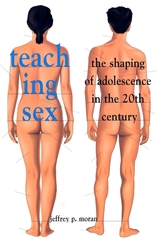 Teaching Sex: The Shaping of Adolescence in the 20th Century
Jeffrey P. Moran
Harvard University Press, 2002 Sex education, since its advent at the dawn of the twentieth century, has provoked the hopes and fears of generations of parents, educators, politicians, and reformers. On its success or failure seems to hinge the moral fate of the nation and its future citizens. But whether we argue over condom distribution to teenagers or the use of an anti-abortion curriculum in high schools, we rarely question the basic premise—that adolescents need to be educated about sex. How did we come to expect the public schools to manage our children’s sexuality? More important, what is it about the adolescent that arouses so much anxiety among adults?
Teaching Sex travels back over the past century to trace the emergence of the “sexual adolescent” and the evolution of the schools’ efforts to teach sex to this captive pupil. Jeffrey Moran takes us on a fascinating ride through America’s sexual mores: from a time when young men were warned about the crippling effects of masturbation, to the belief that schools could and should train adolescents in proper courtship and parenting techniques, to the reemergence of sexual abstention brought by the AIDS crisis. We see how the political and moral anxieties of each era found their way into sex education curricula, reflecting the priorities of the elders more than the concerns of the young.
Moran illuminates the aspirations and limits of sex education and the ability of public authority to shape private behavior. More than a critique of public health policy, Teaching Sex is a broad cultural inquiry into America’s understanding of adolescence, sexual morality, and social reform.
 Teaching Shakespeare into the Twenty-First Century
Ronald E. Salomone
Ohio University Press, 1997 Shakespeare is a central shaping and defining figure in our culture. His plays are being taught, filmed, and performed every day in many places and in most of the world’s languages. At the same time, teachers and students from junior high through the early undergraduate years often struggle with the Bard in discomfort and negativity that can only be counter-productive. Teaching Shakespeare into the Twenty-First Century is by teachers and for teachers. Specifically, it is a collection of essays in which teachers describe their best ideas and experiences as they confront the challenges of bringing Shakespeare alive for students who often feel intimidated and less than eager to participate. It is on behalf of these students that this book has been prepared. Written by middle school, high school, and college teachers from around the country, the essays record successful efforts at bringing Shakespeare and the student together in fresh, exciting, and productive ways. From today’s performance techniques, designed to make students active participants in the learning process, through a host of extra-textual resources such as festivals and films, to a look at applications of the computer and cyberspace, Teaching Shakespeare into the Twenty-First Century is a book of success stories. Covering the most contemporary issues, critical theory, and classroom approach, it is designed to provide teachers with a useful, friendly, and forward-looking resource as they continue to make Shakespeare available into the future.
Teaching Speaking Online: What Every ESL Teacher Needs to Know
Pamela S.H. Bogart
University of Michigan Press, 2020 Whether you are teaching a speaking course online for the first time or transitioning to a face-to-face course to online, Teaching Speaking Online outlines ways to foster spoken language development in online teaching contexts. Because technical problems, economic resources, and student schedules may curtail opportunities for student participation in live, synchronous online classes, this book focuses primarily on asynchronous modes of teaching and learning. Each section emphasizes practical strategies and resources to promote spoken communication: fluency, accuracy, and context-sensitive usage. It outlines proven strategies and ends with reflection questions to invite readers to adopt the best strategies for their teaching.
Teaching Subject, A: Composition Since 1966, New Edition
Joseph Harris
Utah State University Press, 2012 In this classic text, Joseph Harris traces the evolution of college writing instruction since the Dartmouth Seminar of 1966. A Teaching Subject offers a brilliant interpretive history of the first decades during which writing studies came to be imagined as a discipline separable from its partners in English studies. Postscripts to each chapter in this new edition bring the history of composition up to the present. Reviewing the development of the field through five key ideas, Harris unfolds a set of issues and tensions that continue to shape the teaching of writing today. Ultimately, he builds a case, now deeply influential in its own right, that composition defines itself through its interest and investment in the literacy work that students and teachers do together. Unique among English studies fields, composition is, Harris contends, a teaching subject.
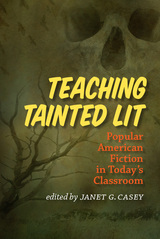 Teaching Tainted Lit: Popular American Fiction in Today's Classroom
Janet G. Casey
University of Iowa Press, 2015 Popular American fiction has now secured a routine position in the higher education classroom despite its historic status as culturally suspect. This newfound respect and inclusion have almost certainly changed the pedagogical landscape, and Teaching Tainted Lit explores that altered terrain. If the academy has historically ignored, or even sneered at, the popular, then its new accommodation within the framework of college English is noteworthy: surely the popular introduces both pleasures and problems that did not exist when faculty exclusively taught literature from an established “high” canon. How, then, does the assumption that the popular matters affect teaching strategies, classroom climates, and both personal and institutional notions about what it means to study literature?
The essays in this collection presume that the popular is here to stay and that its instructive implications are not merely noteworthy, but richly nuanced and deeply compelling. They address a broad variety of issues concerning canonicity, literature, genre, and the classroom, as its contributors teach everything from Stephen King and Lady Gaga to nineteenth-century dime novels and the 1852 best-seller Uncle Tom’s Cabin.
It is no secret that teaching popular texts fuels controversies about the value of cultural studies, the alleged relaxation of aesthetic standards, and the possible “dumbing down” of Americans. By implicitly and explicitly addressing such contentious issues, these essays invite a broader conversation about the place of the popular not only in higher education but in the reading lives of all Americans.
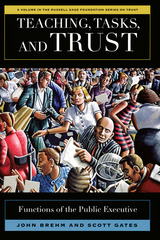 Teaching, Tasks, and Trust: Functions of the Public Executive
John Brehm
Russell Sage Foundation, 2008 The mere word "bureaucracy" brings to mind images of endless lines, piles of paperwork, and frustrating battles over rules and red tape. But some bureaucracies are clearly more efficient and responsive than others. Why? In Teaching, Tasks, and Trust, distinguished political scientists John Brehm and Scott Gates show that a good part of the answer may be found in the roles that middle managers play in teaching and supporting the front-line employees who make a bureaucracy work. Brehm and Gates employ a range of sophisticated modeling and statistical methods in their analysis of employees in federal agencies, police departments, and social service centers. Looking directly at what front-line workers say about their supervisors, they find that employees who feel they have received adequate training have a clearer understanding of the agency's mission, which leads to improved efficiency within their departments. Quality training translates to trust – employees who feel supported and well-trained for the job are more likely to trust their supervisors than those who report being subject to constant monitoring and a strict hierarchy. Managers who "stand up" for employees—to media, government, and other agency officials—are particularly effective in cultivating the trust of their workers. And trust, the authors find, motivates superior job performance and commitment to the agency's mission. Employees who trust their supervisors report that they work harder, put in longer hours, and are less likely to break rules. The authors extend these findings to show that once supervisors grain trust, they enjoy greater latitude in influencing how employees allocate their time while working. Brehm and Gates show how these three executive roles are interrelated—training and protection for employees gives rise to trust, which provides supervisors with the leverage to stimulate improved performance among their workers. This new model—which frames supervisors as teachers and protectors instead of taskmasters—has widespread implications for training a new generation of leaders and creating more efficient organizations. Bureaucracies are notorious for inefficiency, but mid-level supervisors, who are often regarded as powerless, retain tremendous power to build a more productive workforce. Teaching, Tasks, and Trust provides a fascinating glimpse into a bureaucratic world operating below the radar of the public eye—a world we rarely see while waiting in line or filling out paperwork. A Volume in the Russell Sage Foundation Series on Trust
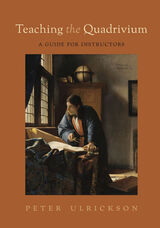 Teaching the Quadrivium: A Guide for Instructors
Peter Ulrickson
Catholic University of America Press, 2023 Reviving an educational tradition involves a double task. A new generation of students must be taught, and at the same time the teachers themselves must learn. This book addresses the teachers who seek to hand on the quadrivium-the four mathematical liberal arts of arithmetic, geometry, music, and astronomy-at the same time as they acquire it.
Two components run in parallel throughout the book. The first component is practical. Weekly overviews and daily lesson plans explain how to complete the study of A Brief Quadrivium in the course of a single school year, and suggestions for weekly assessments make it easy to plan tests and monitor student progress. The second component is directed to the continuing education of the teacher. Short essays explore the history, philosophy, and practice of mathematics. The themes of these essays are coordinated with the simultaneous mathematical work being done by students, allowing the teacher to instruct more reflectively.
Some users of this book are confident in their grasp of mathematics and natural science. For them, the essays will clarify the unity of mathematical activity over time and reveal the old roots of new developments. Other users of this book, including some parents who school their children at home, find mathematics intimidating. The clear structure of the lesson plans, and the support of the companion essays, give them the confidence to lead students through a demanding but doable course of study.
The British mathematician John Edensor Littlewood remarked that one finds in the ancient mathematicians not “clever schoolboys” but rather “Fellows of another College.” This guide invites all teachers of the quadrivium to join the enduring mathematical culture of Littlewood and his predecessors, and to witness for themselves the significance and vitality of a tradition as old as Pythagoras.
Teaching the Bible: Practical Strategies for Classroom Instruction
Mark Roncace
SBL Press, 2005 While books on pedagogy in a theoretical mode have proliferated in recent years, there have been few that offer practical, specific ideas for teaching particular biblical texts. To address this need, Teaching the Bible, a collection of ideas and activities written by dozens of innovative college and seminary professors, outlines effective classroom strategies—with a focus on active learning—for the new teacher and veteran professor alike. It includes everything from ways to incorporate film, literature, art, and music to classroom writing assignments and exercises for groups and individuals. The book assumes an academic approach to the Bible but represents a wide range of methodological, theological, and ideological perspectives. This volume is an indispensable resource for anyone who teaches classes on the Bible.
Teaching the Bible through Popular Culture and the Arts
Mark Roncace
SBL Press, 2007 This resource enables biblical studies instructors to facilitate engaging classroom experiences by drawing on the arts and popular culture. It offers brief overviews of hundreds of easily accessible examples of art, film, literature, music, and other media and outlines strategies for incorporating them effectively and concisely in the classroom. Although designed primarily for college and seminary courses on the Bible, the ideas can easily be adapted for classes such as “Theology and Literature” or “Religion and Art” as well as for nonacademic settings. This compilation is an invaluable resource for anyone who teaches the Bible.
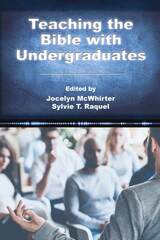 Teaching the Bible with Undergraduates
Jocelyn McWhirter
SBL Press, 2022 Teaching the Bible with Undergraduates offers concrete strategies for Bible instruction in college classrooms. Each essay pays special attention to the needs of tech-savvy students whose sensibilities, aspirations, expectations, and preferred ways of learning may differ significantly from those of their instructors. The volume’s contributors, all biblical scholars and undergraduate instructors, focus on best pedagogical practices using concrete examples while sharing effective strategies. Essays and quick tips treat topics, including general education, reading skills, student identities, experiential learning, and instructional technology. Contributors include Kimberly Bauser McBrien, George Branch-Trevathan, Callie Callon, Lesley DiFransico, Nicholas A. Elder, Timothy A. Gabrielson, Kathleen Gallagher Elkins, Susan E. Haddox, Seth Heringer, John Hilton III, Melanie A. Howard, Christopher M. Jones, Steve Jung, Katherine Low, Timothy Luckritz Marquis, Kara J. Lyons-Pardue, Jocelyn McWhirter, Sylvie T. Raquel, Eric A. Seibert, Hanna Tervanotko, Carl N. Toney, John Van Maaren, and Robby Waddell. This book provides an essential resource not only for instructors at the undergraduate level but also for anyone who teaches biblical studies in the classroom.
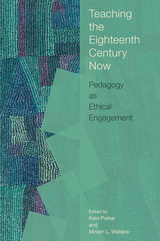 Teaching the Eighteenth Century Now: Pedagogy as Ethical Engagement
Kate Parker
Bucknell University Press, 2024 In this timely collection, teacher-scholars of “the long eighteenth century,” a Eurocentric time frame from about 1680 to 1832, consider what teaching means in this historical moment: one of attacks on education, a global contagion, and a reckoning with centuries of trauma experienced by Black, Indigenous, and immigrant peoples. Taking up this challenge, each essay highlights the intellectual labor of the classroom, linking textual and cultural materials that fascinate us as researchers with pedagogical approaches that engage contemporary students. Some essays offer practical models for teaching through editing, sensory experience, dialogue, or collaborative projects. Others reframe familiar texts and topics through contemporary approaches, such as the health humanities, disability studies, and decolonial teaching. Throughout, authors reflect on what it is that we do when we teach—how our pedagogies can be more meaningful, more impactful, and more relevant.
Published by Bucknell University Press. Distributed worldwide by Rutgers University Press.
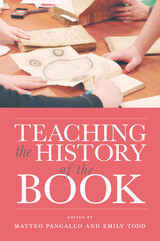 Teaching the History of the Book
Edited by Matteo Pangallo and Emily B. Todd
University of Massachusetts Press, 2023 With original contributions from a diverse range of teachers, scholars, and practitioners in literary studies, history, book arts, library science, language studies, and archives, Teaching the History of the Book is the first collection of its kind dedicated to book history pedagogy. Presenting a variety of methods for teaching book history both as its own subject and as an approach to other material, each chapter describes lessons, courses, and programs centered on the latest and best ways of teaching undergraduate and graduate students. Expansive and instructive, this volume introduces ways of helping students consider how texts were produced, circulated, and received, with chapters that cover effective ways to organize courses devoted to book history, classroom activities that draw on this subject in other courses, and an overview of selected print and digital tools. Contributors, many of whom are leading figures in the field, utilize their own classroom experiences to bring to life some of the rich possibilities for teaching book history in the twenty-first century. In addition to the volume editors, contributors include Ryan Cordell, Brigitte Fielder, Barbara Hochman, Leslie Howsam, Matthew Kirschenbaum, Clare Mullaney, Kate Ozment, Leah Price, Jonathan Rose, Jonathan Senchyne, Sarah Wadsworth, and others.
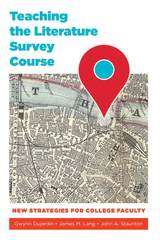 Teaching the Literature Survey Course: New Strategies for College Faculty
James M. Lang
West Virginia University Press, 2018 Teaching the Literature Survey Course makes the case for maintaining—even while re-imagining and re-inventing—the place of the survey as a transformative experience for literature students. Through essays both practical and theoretical, the collection presents survey teachers with an exciting range of new strategies for energizing their teaching and engaging their students in this vital encounter with our evolving literary traditions.
From mapping early English literature to a team-based approach to the American survey, and from multimedia galleries to a “blank syllabus,” contributors propose alternatives to the traditional emphasis on lectures and breadth of coverage. The volume is at once a set of practical suggestions for working teachers (including sample documents like worksheets and syllabi) and a provocative engagement with the question of what introductory courses can and should be.
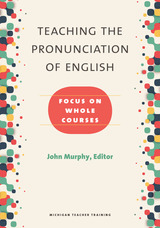 Teaching the Pronunciation of English: Focus on Whole Courses
John Murphy, Editor
University of Michigan Press, 2017 This volume fills a gap by introducing readers to whole courses focused on teaching the pronunciation of English as a second, foreign, or international language. This collection is designed to support more effective pronunciation teaching in as many language classrooms in as many different parts of the world as possible and to serve as a core text in a teacher development course dedicated to preparing teachers of ESL pronunciation.
Teaching the Pronunciation of English illustrates that pronunciation teaching is compatible with communicative, task-based, post-method, and technology-mediated approaches to language teaching. This theme permeates the volume as a whole and is well represented in Chapters 3-12, which are dedicated to specialist-teachers’ firsthand depictions of pronunciation-centered courses. Each of these ten chapters features a set of innovative teaching strategies and contemporary course design structures developed by the chapter contributor(s).
To prepare readers to more fully appreciate the substance and quality of Chapters 3-12, the volume’s two initial chapters are more foundational. Chapters 1 and 2 provide an overview of core topics language teachers need to know about to become pronunciation teachers: suprasegmentals (thought groups, prominence, word stress, intonation, and pitch jumps) and the English consonants and vowel sounds.
 Teaching through the Archives: Text, Collaboration, and Activism
Edited by Tarez Samra Graban and Wendy Hayden
Southern Illinois University Press, 2022 Disruptive pedagogies for archival research
In a cultural moment when institutional repositories carry valuable secrets to the present and past, this collection argues for the critical, intellectual, and social value of archival instruction. Graban and Hayden and 37 other contributors examine how undergraduate and graduate courses in rhetoric, history, community literacy, and professional writing can successfully engage students in archival research in its many forms, and successfully model mutually beneficial relationships between archivists, instructors, and community organizations. Combining new and established voices from related fields, each of the book’s three sections includes a range of form-disrupting pedagogies. Section I focuses on how approaching the archive primarily as text fosters habits of mind essential for creating and using archives, for critiquing or inventing knowledge-making practices, and for being good stewards of private and public collections. Section II argues for conducting archival projects as collaboration through experiential learning and for developing a preservationist consciousness through disciplined research. Section III details praxis for revealing, critiquing, and intervening in historic racial omissions and gaps in the archives in which we all work. Ultimately, contributors explore archives as sites of activism while also raising important questions that persist in rhetoric and composition scholarship, such as how to decolonize research methodologies, how to conduct teaching and research that promote social justice, and how to shift archival consciousness toward more engaged notions of democracy. This collection highlights innovative classroom and curricular course models for teaching with and through the archives in rhetoric and composition and beyond.
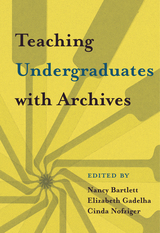 Teaching Undergraduates with Archives
Nancy Bartlett
Michigan Publishing, 2019 Teaching Undergraduates with Archives mirrors the evolving practice and academic research on primary sources in the classroom. The result of a national symposium at the University of Michigan in 2018, the volume features case studies, reflections, and forecasts concerning critical thinking, active learning, and archival evidence. The chapters describe collaborations between faculty, archivists, librarians, and students. Ideas behind new assignments and syllabi provide an immediate utility for those who teach with primary sources. Testimonies to the challenges and benefits of robust programs speak to the emerging prioritization of teaching and learning across disciplines with archives and special collections.
"The contributions to this volume capture exceptionally well the passion and the creativity that archivists and special collections librarians who teach and do outreach with primary sources are bringing to their work in this increasingly important activity domain."
-- Martha O’Hara Conway, Director, Special Collections Research Center, University of Michigan Library
"As teaching with archival materials has moved to the foreground of the archival mission for many institutions, this timely, inspiring, and practical volume, which comes out of the multi-day symposium solely devoted to teaching undergraduates with archival materials, is a required reading for anyone who teaches with archival materials, or who would like to. It really captures the spirit and enthusiasm that these authors brought to that symposium."
-- Josué Hurtado, Coordinator of Public Services & Outreach, Special Collections Research Center, Temple University Libraries
"Reflecting the increasing priority of teaching in archives and special collections libraries, this book captures a variety of perspectives, insights, approaches, and prognostications that will enlighten, challenge, and inspire a growing community of practitioners."
-- Bill Landis, Head of Public Services, Manuscripts and Archives, Yale University Library
"Building on the momentum generated at the symposium, this book is a treasure trove for professionals in the field who are eager for innovative ideas regarding collaboration and experimentation in teaching with archival material."
-- Elizabeth Williams-Clymer, Special Collections Librarian, Kenyon College
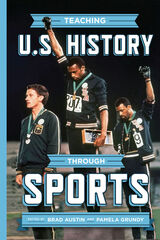 Teaching U.S. History through Sports
Edited by Brad Austin and Pamela Grundy
University of Wisconsin Press, 2022 Few areas of study offer more insight into American culture than competitive sports. The games played throughout this nation's history dramatically illuminate social, economic, and cultural developments, from the balance of power in world affairs to changing conceptions of race, gender, and sexuality.
Teaching U.S. History through Sports provides strategies for incorporating sports into any U.S. history curriculum. Drawing upon their own classroom experiences, the authors suggest creative ways to use sports as a lens to examine a broad range of historical subjects, including Puritan culture, the rise of Jim Crow, the Cold War, the civil rights movement, and the women's movement. Essays focus on the experiences of African American women, working-class southerners, Latinos, and members of LGBTQ communities, as well as topics including the controversy over Native American mascots and the globalization of U.S. sports.
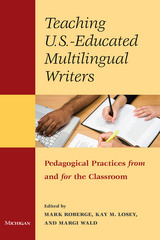 Teaching U.S.-Educated Multilingual Writers: Pedagogical Practices from and for the Classroom
Mark Roberge, Kay M. Losey, Margi Wald
University of Michigan Press, 2015 This volume was born to address the lack of classroom-oriented scholarship regarding U.S.-educated multilingual writers. Unlike prior volumes about U.S.-educated multilinguals, this book focuses solely on pedagogy--from classroom activities and writing assignments to course curricula and pedagogical support programs outside the immediate classroom. Unlike many pedagogical volumes that are written in the voice of an expert researcher-theorist, this volume is based on the notion of teachers sharing practices with teachers.
All of the contributors are teachers who are writing about and reflecting on their own experiences and outcomes and interweaving those experiences and outcomes with current theory and research in the field. The volume thus portrays teachers as active, reflective participants engaged in critical inquiry. Contributors represent community college, college, and university contexts; academic ESL, developmental writing, and first-year composition classes; and face-to-face, hybrid, and online contexts.
This book was developed primarily to meet the needs of practicing writing teachers in college-level ESL, basic writing, and college composition classrooms, but will also be useful to pre-service teachers in TESOL, Composition, and Education graduate programs.
Teaching Vocabulary Is the Writing Teacher's Job: Why and How
Keith S. Folse
University of Michigan Press, 2020 While most teachers acknowledge the importance of vocabulary in learning a new language, many assume a reading class or other teacher will cover vocabulary. Yet vocabulary plays an essential role in good writing, especially academic writing. Teaching Vocabulary Is the Writing Teacher’s Job explores the serious nature of ESL students’ lexical plight and looks at vocabulary in relation to reading, speaking, listening, and writing proficiency. It also examines the role of vocabulary in ESL writing assessment. In the conclusion, author Keith Folse discusses eight research-based suggestions for writing teachers, including encouraging students to become vocabulary detectives, teaching collocations, testing vocabulary, and teaching paraphrasing and summarizing.
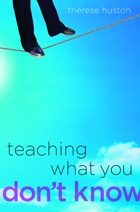 Teaching What You Don’t Know
Therese Huston
Harvard University Press, 2012 Your graduate work was on bacterial evolution, but now you're lecturing to 200 freshmen on primate social life. You've taught Kant for twenty years, but now you're team-teaching a new course on “Ethics and the Internet.” The personality theorist retired and wasn't replaced, so now you, the neuroscientist, have to teach the "Sexual Identity" course. Everyone in academia knows it and no one likes to admit it: faculty often have to teach courses in areas they don't know very well. The challenges are even greater when students don't share your cultural background, lifestyle, or assumptions about how to behave in a classroom.
In this practical and funny book, an experienced teaching consultant offers many creative strategies for dealing with typical problems. How can you prepare most efficiently for a new course in a new area? How do you look credible? And what do you do when you don't have a clue how to answer a question?
Encouraging faculty to think of themselves as learners rather than as experts, Therese Huston points out that authority in the classroom doesn't come only, or even mostly, from perfect knowledge. She offers tips for introducing new topics in a lively style, for gauging students' understanding, for reaching unresponsive students, for maintaining discussions when they seem to stop dead, and -yes- for dealing with those impossible questions.
Original, useful, and hopeful, this book reminds you that teaching what you don't know, to students whom you may not understand, is not just a job. It's an adventure.
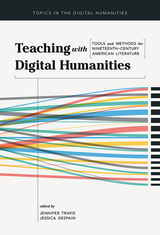 Teaching with Digital Humanities: Tools and Methods for Nineteenth-Century American Literature
Jennifer Travis, Jessica DeSpain
University of Illinois Press, 2018 Jennifer Travis and Jessica DeSpain present a long-overdue collection of theoretical perspectives and case studies aimed at teaching nineteenth-century American literature using digital humanities tools and methods. Scholars foundational to the development of digital humanities join educators who have made digital methods central to their practices. Together they discuss and illustrate how digital pedagogies deepen student learning. The collection's innovative approach allows the works to be read in any order. Travis and DeSpain curate conversations on the value of project-based, collaborative learning; examples of real-world assignments where students combine close, collaborative, and computational reading; how digital humanities aids in the consideration of marginal texts; the ways in which an ethics of care can help students organize artifacts; and how an activist approach affects debates central to the study of difference in the nineteenth century. A supplemental companion website with substantial appendixes of syllabi and assignments is now available for readers of Teaching with Digital Humanities.
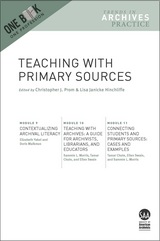 Teaching with Primary Sources
Christopher Prom
Society of American Archivists, 2016 Teaching With Primary Sources is part of the series Trends in Archives Practice. It includes three modules:
Module 9: Contextualizing Archival Literacy
by Elizabeth Yakel and Doris Malkmus
Examines the evolving theory of archival literacy in relation to domain knowledge, primary source literacy, and information literacy to facilitate meaningful use of archival and manuscript collections.
Module 10: Teaching With Archives: A Guide for Archivists, Librarians, and Educators
by Sammie L. Morris, Tamar Chute, and Ellen Swain
Provides practical guidance to archivists, librarians,and educators on teaching with archival materials,offering tips for beginners as well as seasoned instructors.
Module 11: Connecting Students and Primary Sources: Cases and Examples
by Tamar Chute, Ellen Swain, and Sammie L. Morris
Offers readers an analytical guide and example assignments for teaching with primary materials, based heavily on first-hand case study accounts and interviews with practitioners and experts in the field.
As Lisa Janicke Hinchliffe notes in the introduction, "These three modules present a wealth of resources for meeting the challenges of primary source literacy instruction. They can be read start-to-finish to build a foundation for practice. Or, they can be dipped into as needed by the busy educator who needs practical ideas or inspiration for that next instruction session."
Teaching With Student Texts: Essays Toward an Informed Practice
Joseph Harris
Utah State University Press, 2010 Harris, Miles and Paine ask: What happens when the texts that students write become the focus of a writing course? In response, a distinguished group of scholar/teachers suggests that teaching with students texts is not simply a classroom technique, but a way of working with writing that defines composition as a field.
In Teaching with Student Texts, authors discuss ways of revaluing student writing as intellectual work, of circulating student texts in the classroom and beyond, and of changing our classroom practices by bringing student writings to the table. Together, these essays articulate a variety of ways that student texts can take a central place in classroom work and can, in the process, redefine the ways our field talks about writing.
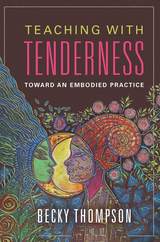 Teaching with Tenderness: Toward an Embodied Practice
Becky Thompson
University of Illinois Press, 2017 Imagine a classroom that explores the twinned ideas of embodied teaching and a pedagogy of tenderness. Becky Thompson envisions such a curriculum--and a way of being--that promises to bring about a sea change in education. Teaching with Tenderness follows in the tradition of bell hooks's Teaching to Transgress and Paulo Freire's Pedagogy of the Oppressed, inviting us to draw upon contemplative practices (yoga, meditation, free writing, mindfulness, ritual) to keep our hearts open as we reckon with multiple injustices. Teaching with tenderness makes room for emotion, offers a witness for experiences people have buried, welcomes silence, breath and movement, and sees justice as key to our survival. It allows us to rethink our relationship to grading, office hours, desks, and faculty meetings, sees paradox as a constant companion, moves us beyond binaries; and praises self and community care. Tenderness examines contemporary challenges to teaching about race, gender, class, nationality, sexuality, religion, and other hierarchies. It examines the ethical, emotional, political, and spiritual challenges of teaching power-laden, charged issues and the consequences of shifting power relations in the classroom and in the community. Attention to current contributions in the areas of contemplative practices, trauma theory, multiracial feminist pedagogy, and activism enable us to envision steps toward a pedagogy of liberation. The book encourages active engagement and makes room for self-reflective learning, teaching, and scholarship.
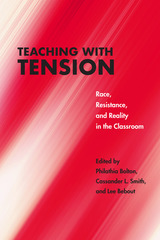 Teaching with Tension: Race, Resistance, and Reality in the Classroom
Edited by Philathia Bolton, Cassander L. Smith, and Lee Bebout
Northwestern University Press, 2019 Teaching with Tension is a collection of seventeen original essays that address the extent to which attitudes about race, impacted by the current political moment in the United States, have produced pedagogical challenges for professors in the humanities. As a flashpoint, this current political moment is defined by the visibility of the country's first black president, the election of his successor, whose presidency has been associated with an increased visibility of the alt-right, and the emergence of the neoliberal university. Together these social currents shape the tensions with which we teach.
Drawing together personal reflection, pedagogical strategies, and critical theory, Teaching with Tension offers concrete examinations that will foster student learning. The essays are organized into three thematic sections: "Teaching in Times and Places of Struggle" examines the dynamics of teaching race during the current moment, marked by neoconservative politics and twenty-first century freedom struggles. "Teaching in the Neoliberal University" focuses on how pressures and exigencies of neoliberalism (such as individualism, customer-service models of education, and online courses) impact the way in which race is taught and conceptualized in college classes. The final section, "Teaching How to Read Race and (Counter)Narratives," homes in on direct strategies used to historicize race in classrooms comprised of millennials who grapple with race neutral ideologies. Taken together, these sections and their constitutive essays offer rich and fruitful insight into the complex dynamics of contemporary race and ethnic studies education.
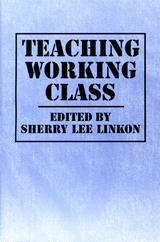 Teaching Working Class
Sherry Lee Linkon
University of Massachusetts Press, 1999 Since the 1970s, working-class individuals have made up an increasing proportion of students enrolled in institutions of higher education. At the same time, working-class studies has emerged as a new academic discipline, updating a long tradition of scholarship on labor history and proletarian literature to include discussions of working-class culture, intersections of class with race and ethnicity, and studies of the representation of the working class in popular culture. These developments have generated new ideas about teaching that incorporate both a sensitivity to the working-class roots of many students and the inclusion of course content informed by an awareness of class culture. This volume brings together nineteen essays that offer innovative approaches to a class-conscious pedagogy. Although the contributors represent several fields—including English, history, labor studies, literature, speech communication, and American studies—they are united by the conviction that class matters in all kinds of courses. Their essays provide models for interdisciplinary teaching as well as guidance, encouragement, and insight for those wishing to incorporate class into their courses.
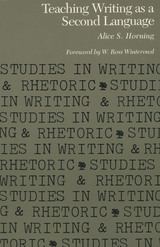 Teaching Writing as a Second Language
Alice S. Horning. Foreword by W. Ross Winterowd
Southern Illinois University Press, 1986 Classrooms filled with glassy-eyed students provide an experiential base for Alice S. Horning’s new comprehensive theory about basic writers. Horning explores the theory of writing acquisition in detail. Her examination of spoken and written language and redundancy give a theoretical base to her argument that academic discourse is a separate linguistic system characterized by particular psycholinguistic features. She proposes that basic writers learn to write as other learners master a second language because for them, academic written English is a whole new language. She explores the many connections to be found in second language acquisition research to the teaching and learning of writing and gives special attention to the interlanguage hypothesis, pidginization theory, and the Monitor theory. She also addresses the role of affective factors (feelings, attitudes, emotions, and motivation) in the success or failure of writing students.
Teaching Writing: Landmarks and Horizons
Edited by Christina Russell McDonald and Robert L. McDonald. Foreword by Gary Tate. Postscript by Steve North
Southern Illinois University Press, 2002
Teaching Writing: Landmarks and Horizons, edited by Christina Russell McDonald and Robert L. McDonald, is designed to present an overview of some of the major developments in the establishment of composition studies as a field during the past thirty-five years. The essays are theoretically grounded but are focused on pedagogy as well. Divided into two parts, the first presents nine landmark essays, selected and introduced by distinguished composition scholars, and the second brings together eight new essays by emerging scholars.
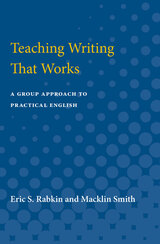 Teaching Writing That Works: A Group Approach to Practical English
Eric S. Rabkin and Macklin Smith
University of Michigan Press, 1990 Expressing ourselves well in written communication is important to many areas of our lives, and essential in the working world. Many courses that seek to prepare students for professional writing, however, overlook the fact that most real-world writing is produced by and for people working within groups. Teaching Writing That Works offers composition instructors an alternative to the conventional composition course in which one individual (a student) writes in isolation for another isolated individual (the teacher).The result of Rabkin and Smith's innovative, non-hierarchical approach to composition learning is Practical English, a course developed at the University of Michigan. In this successful and popular course, the choice and execution of writing tasks are the responsibility of students working together in groups rather than working alone as individuals. The crucial rhetorical issues of audience and purpose are focused by having students use their writing to do real work, both within the classroom and beyond it. The writing that evolves from this collaboration is then edited and evaluated by the group. In this emphasis on students' authority over and responsibility for the learning process, Teaching Writing That Works reflects current pedagogical concerns and philosophy.The busy teacher looking for fresh approaches for the composition classroom but with no time to develop a whole new course from the bottom up will appreciate the book's full descriptions of the Michigan course. The authors provide an outline of the curriculum and thorough explanations of teaching techniques for the course, as well as a detailed discussion of the workshop practicum and its application. Much of the practical advice and theoretical discussion can be imported into existing courses as self-contained units. Selections from students' comments on the course enhance the text and offer glimpses into the reasons for the course's popularity among students—and teachers.
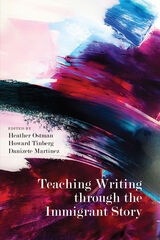 Teaching Writing through the Immigrant Story
Heather Ostman
Utah State University Press, 2021 Teaching Writing through the Immigrant Story explores the intersection between immigration and pedagogy via the narrative form. Embedded in the contexts of both student writing and student reading of literature chapters by scholars from four-year and two-year colleges and universities across the country, this book engages the topic of immigration within writing and literature courses as the site for extending, critiquing, and challenging assumptions about justice and equity while deepening students’ sense of ethics and humanity.
Each of the chapters recognizes the prevalence of immigrant students in writing classrooms across the United States—including foreign-born, first- and second-generation Americans, and more—and the myriad opportunities and challenges those students present to their instructors. These contributors have seen the validity in the stories and experiences these students bring to the classroom—evidence of their lifetimes of complex learning in both academic and nonacademic settings. Like thousands of college-level instructors in the United States, they have immigrant stories of their own. The immigrant “narrative” offers a unique framework for knowledge production in which students and teachers may learn from each other, in which the ordinary power dynamic of teacher and students begins to shift, to enable empathy to emerge and to provide space for an authentic kind of pedagogy.
By engaging writing and literature teachers within and outside the classroom, Teaching Writing through the Immigrant Story speaks to the immigrant narrative as a viable frame for teaching writing—an opportunity for building and articulating knowledge through academic discourse. The book creates a platform for immigration as a writing and literary theme, a framework for critical thinking, and a foundation for significant social change and advocacy.
Contributors: Tuli Chatterji, Katie Daily-Bruckner, Libby Garland, Silvia Giagnoni, Sibylle Gruber, John Havard, Timothy Henderson, Brennan Herring, Lilian Mina, Rachel Pate, Emily Schnee, Elizabeth Stone
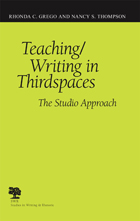 Teaching/Writing in Thirdspaces: The Studio Approach
Rhonda C. Grego and Nancy S. Thompson
Southern Illinois University Press, 2007 Teaching/Writing in Thirdspaces: The Studio Approach examines a dynamic approach to teaching composition that reimagines not only the physical space in which writing and learning occurs but also the place occupied by composition in the power structure of universities and colleges. In response to financial and programmatic cutbacks at the University of South Carolina in the 1990s, authors Rhonda C. Grego and Nancy S. Thompson used their academic backgrounds in composition and English education, along with their personal histories in working-class families, to look at compositional spaces and places with an eye to challenging the embedded issues of race, class, and gender within the university hierarchies. The result was a supplemental writing program that they called the writing studio. The studio model emphasizes individual participation in a small group that allows students to present work they are preparing for outside classes, discuss their challenges, and refine their ideas with other students and staff facilitators. This “interactional inquiry” is replicated and reinforced by the facilitators, who meet in their own small groups to analyze larger patterns, possibilities, and needs as they arise in their studios. Grego and Thompson argue that because the studio is physically and institutionally “outside but alongside” both students’ other coursework and the hierarchy of the institution, it represents a “thirdspace,” a unique position in which to effect institutional change. The focus on interactional inquiry challenges traditional power hierarchies within classrooms and shifts the nature of discourse. As a bottom-up approach to the development of educational programs within institutions that have different needs, demographies, and histories, the studio model can address a multitude of different institutional needs with little disruption to the curriculum. The studio model allows university administrators, teachers, student aides, and students to continually adapt to changing institutional environments with new teaching and learning strategies. Teaching/Writing in Thirdspaces provides an alternative approach to traditional basic writing courses that can be adopted in educational institutions of all types and at all levels.
The Teacup Ministry and Other Stories: Subtle Boundaries of Class
By Rhoda H. Halperin
University of Texas Press, 2001 In the global world of the twenty-first century, class boundaries are subtle and permeable, though real nonetheless. Markers of identity, authenticity, and belonging can change with a gesture or a glance, making people feel they do or don't belong in certain places, with certain people, at certain times. In these powerfully written ethnographic stories, Rhoda Halperin maps the boundaries of class by examining three themes: crossing class boundaries, class creativity, and class vulnerability.
In telling these stories, Halperin draws on a wealth of ethnographic experiences in this country and abroad. Her book challenges class stereotypes in ways that touch on universals across cultures and over time.
Team 10 East: Revisionist Architecture in Real Existing Modernism
Edited by Lukasz Stanek
Museum of Modern Art in Warsaw, 2014 This volume coins the term “Team 10 East” as a conceptual tool to discuss the work of Team 10 members and fellow travelers from state-socialist countries—such as Oskar Hansen of Poland, Charles Polónyi of Hungary, and Radovan Nikšic of Yugoslavia. This new term allows the book’s contributors to approach these individuals from a comparative perspective on socialist modernism in Central and Eastern Europe and to discuss the relationship between modernism and modernization across the Iron Curtain. In so doing, Team 10 East addresses “revisionism” in state-socialist architecture and politics as well as shows how Team 10 East architects appropriated, critiqued, and developed postwar modernist architecture and functionalist urbanism both from within and beyond the confines of a Europe split by the Cold War.
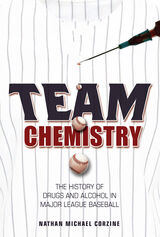 Team Chemistry: The History of Drugs and Alcohol in Major League Baseball
Nathan Corzine
University of Illinois Press, 2016 In 2007, the Mitchell Report shocked traditionalists who were appalled that drugs had corrupted the "pure" game of baseball. Nathan Corzine rescues the story of baseball's relationship with drugs from the sepia-toned tyranny of such myths. In Team Chemistry , he reveals a game splashed with spilled whiskey and tobacco stains from the day the first pitch was thrown. Indeed, throughout the game's history, stars and scrubs alike partook of a pharmacopeia that helped them stay on the field and cope off of it: - In 1889, Pud Galvin tried a testosterone-derived "elixir" to help him pile up some of his 646 complete games.
- Sandy Koufax needed Codeine and an anti-inflammatory used on horses to pitch through his late-career elbow woes.
- Players returning from World War II mainstreamed the use of the amphetamines they had used as servicemen.
- Vida Blue invited teammates to cocaine parties, Tim Raines used it to stay awake on the bench, and Will McEnaney snorted it between innings.
Corzine also ventures outside the lines to show how authorities handled--or failed to handle--drug and alcohol problems, and how those problems both shaped and scarred the game. The result is an eye-opening look at what baseball's relationship with substances legal and otherwise tells us about culture, society, and masculinity in America.
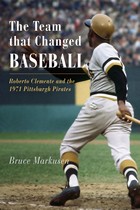 The Team That Changed Baseball: Roberto Clemente and the 1971 Pittsburgh Pirates
Bruce Markusen
Westholme Publishing, 2006 The Inspiring Story of Roberto Clemente's Greatest Season and One of the Most Important Teams in Sport History
In 1947, major league baseball experienced its first measure of integration when the Brooklyn Dodgers brought Jackie Robinson to the National League. While Robinson's breakthrough opened the gates of opportunity for African Americans and other minority players, the process of integration proved slow and uneven. It was not until the 1960s that a handful of major league teams began to boast more than a few Black and Latino players. But the 1971 World Championship team enjoyed a full and complete level of integration, with half of its twenty-five-man roster comprised of players of African American and Latino descent. That team was the Pittsburgh Pirates, managed by an old-time Irishman. In The Team That Changed Baseball: Roberto Clemente and the 1971 Pittsburgh Pirates, veteran baseball writer Bruce Markusen tells the story of one of the most likable and significant teams in the history of professional sports. In addition to the fact that they fielded the first all-minority lineup in major league history, the 1971 Pirates are noteworthy for the team's inspiring individual performances, including those of future Hall of Famers Roberto Clemente, Willie Stargell, and Bill Mazeroski, and their remarkable World Series victory over the heavily favored Baltimore Orioles. But perhaps their greatest legacy is the team's influence on the future of baseball, inspiring later championship teams such as the New York Yankees and Oakland Athletics to open their doors fully to all talented players, regardless of race, particularly in the new era of free agency.
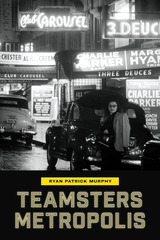 Teamsters Metropolis
Ryan Patrick Murphy
University of Michigan Press, 2025 In the 1950s, the International Brotherhood of Teamsters empowered poor immigrants who had grown up in the crowded blocks of the central city to move upward and outward to comfortable suburbs. It delivered unprecedented benefits to workers—especially to those in retail, services, and light manufacturing—locking in hourly pay that bought the patio furniture sets, the pontoon boats, and the station wagons that defined the consumer culture of the decade. Yet suburban comfort came with strict, new institutions that defined the middle-class culture of the era: the nuclear family, heterosexual monogamy, the husband breadwinner, and the dependent wife. Many workers yearned for the pleasures they left behind in the core of the industrial city, even as poor people, people of color, and queer people were locked out of the suburbs.
Teamsters Metropolis argues that the union achieved unprecedented organizing success in the immediate postwar period precisely because its members defied bourgeois cultural standards. They wore overly flamboyant clothes, instigated jarringly violent confrontations, used aliases, extorted money, flouted the law, and often blended friendship, sex, and love in a way that challenged the boundaries of heteronormativity. Perhaps no one exemplified this freedom more than Jimmy Hoffa, who delivered better pay and worker conditions to marginal workers while also using coercive tactics, embezzling money, and colluding with the Mafia. Rather than impeding the union’s growth, unruly organizing, illicit business techniques, and dissident cultural practices appealed to prospective members and offered an opportunity to circumvent some of the suburban regulations, helping the International Brotherhood of Teamsters become the largest U.S. union of the mid-twentieth century.
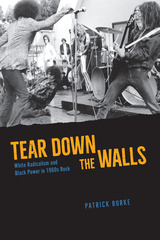 Tear Down the Walls: White Radicalism and Black Power in 1960s Rock
Patrick Burke
University of Chicago Press, 2021 From the earliest days of rock and roll, white artists regularly achieved fame, wealth, and success that eluded the Black artists whose work had preceded and inspired them. This dynamic continued into the 1960s, even as the music and its fans grew to be more engaged with political issues regarding race. In Tear Down the Walls, Patrick Burke tells the story of white American and British rock musicians’ engagement with Black Power politics and African American music during the volatile years of 1968 and 1969. The book sheds new light on a significant but overlooked facet of 1960s rock—white musicians and audiences casting themselves as political revolutionaries by enacting a romanticized vision of African American identity. These artists’ attempts to cast themselves as revolutionary were often naïve, misguided, or arrogant, but they could also reflect genuine interest in African American music and culture and sincere investment in anti-racist politics. White musicians such as those in popular rock groups Jefferson Airplane, the Rolling Stones, and the MC5, fascinated with Black performance and rhetoric, simultaneously perpetuated a long history of racial appropriation and misrepresentation and made thoughtful, self-aware attempts to respectfully present African American music in forms that white leftists found politically relevant. In Tear Down the Walls Patrick Burke neither condemns white rock musicians as inauthentic nor elevates them as revolutionary. The result is a fresh look at 1960s rock that provides new insight into how popular music both reflects and informs our ideas about race and how white musicians and activists can engage meaningfully with Black political movements.
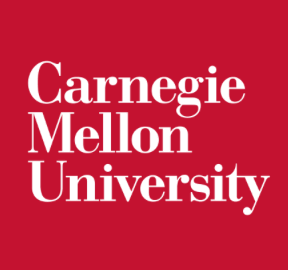 Tear Here: a Novel
Matthew Pitt
Carnegie Mellon University Press, 2026 Reflects on the dark rise and fall of an ambitious rock music collective in the upper Midwest.
Matthew Pitt’s first novel draws from characters introduced in his debut story collection. The rock band Some Assault—comprised of dropouts and hedonists—flails from gig to gig, directed by their volatile drummer Liddy, who careens between foster homes and addictions. She and the band strike up a surprise friendship with Charlie Shales, their remedial algebra teacher. At first, this link is transactional, with Shales seeking drugs and the band seeking a customer. Before long, an odd and meaningful bond is formed.
When Charlie later passes, Liddy orchestrates an elaborate sonic empire, dismissing her own health woes. She recruits new members with targeted zeal, including Oliv, heiress to twin fortunes in condiment packaging and shortbread cookies. Deploying Oliv’s funds to buy a shuttered women’s prison, Some Assault converts the acreage into a farm collective and a massive recording studio dubbed The Hive.
Misfits continue to swell Some Assault’s roster, lured by The Hive’s promise of security and rabid praise: Andy Warhol’s Factory in an Instagram age. However, once the band’s fifteen minutes of fame threaten to expire, territorial violence rises, driven by dark desires to command the public eye at all costs. Chronicled by a member who managed to flee The Hive, Tear Here surveys the fierce fallout of cravings for celebrity that warp into cultish conduct.
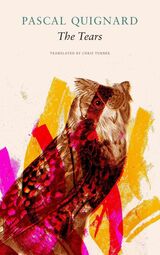 The Tears
Pascal Quignard
Seagull Books, 2023 A novel of intersecting historical threads.
The Tears is, at one level, a novel about the turbulent lives of twins, the sons of Charlemagne’s daughter Bertha. The studious and scholarly Nithard succeeds his father Angilbert as lay abbot of the Abbey of Saint Riquier in Normandy and accompanies his cousin the emperor Charles the Bald on his military campaigns. His twin brother Hartnid strikes out boldly for more exotic parts—including, eventually, Baghdad—in a seemingly deranged quest to track down the elusive female face that haunts his dreams. Yet this novel of intersecting historical threads and patches of poetic reimagining is crisscrossed by a host of other themes: the enigmatic joys afforded by nature, the intimate relation between living creatures which literature has since earliest times depicted, and the mysterious power of contingent events that have shaped entire cultures—including the birth of the French language itself. This heady brew of medieval chronicle, miraculous folktale, and speculative reconstruction of history further strengthens Pascal Quignard’s status as one of France’s most imaginative contemporary writers.
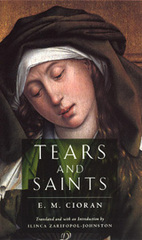 Tears and Saints
E. M. Cioran
University of Chicago Press, 1995 By the mid-1930s, Emil Cioran was already known as a leader of a new generation of politically committed Romanian intellectuals. Researching another, more radical book, Cioran was spending hours in a library poring over the lives of saints. As a modern hagiographer, Cioran "dreamt" himself "the chronicler of these saints' falls between heaven and earth, the intimate knower of the ardors in their hearts, the historian of God's insomniacs." Inspired by Nietzsche's Beyond Good and Evil, Cioran "searched for the origin of tears." He asked himself if saints could be "the sources of tears' better light."
"Who can tell?" he wrote in the first paragraph of this book, first published in Romania in 1937. "To be sure, tears are their trace. Tears did not enter the world through the saints; but without them we would never have known that we cry because we long for a lost paradise." By following in their traces, "wetting the soles of one's feet in their tears," Cioran hoped to understand how a human being can renounce being human. Written in Cioran's characteristic aphoristic style, this flamboyant, bold, and provocative book is one of his most important—and revelatory—works.
Cioran focuses not on martyrs or heroes but on the mystics—primarily female—famous for their keening spirituality and intimate knowledge of God. Their Christianity was anti-theological, anti-institutional, and based solely on intuition and sentiment. Many, such as Catherine of Siena, Teresa of Avila, and Saint John of the Cross, have produced classic works of mystical literature; but Cioran celebrates many more minor and unusual figures as well.
Following Nietzsche, he focuses explicitly on the political element hidden in saints' lives. In his hands, however, their charitable deeds are much less interesting than their thirst for pain and their equally powerful capacity to endure it. Behind their suffering and their uncanny ability to renounce everything through ascetic practices, Cioran detects a fanatical will to power.
"Like Nietzsche, Cioran is an important religious thinker. His book intertwines God and music with passion and tears. . . . [Tears and Saints] has a chillingly contemporary ring that makes this translation important here and now."—Booklist
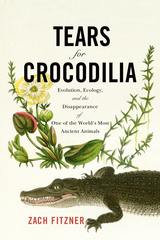 Tears for Crocodilia: Evolution, Ecology, and the Disappearance of One of the World's Most Ancient Animals
Zach Fitzner
Westholme Publishing, 2025 Seventy million years ago in what would become North America, a monstrous thirty-five-foot-long Cretaceous crocodile lurked on a marshy riverbank. Springing suddenly, its huge jaws trapped and crushed a juvenile hadrosaur. Today, the remains of that ancient crocodile are being painstakingly reconstructed in Colorado, where naturalist Zach Fitzner continues his life-long fascination with this amazing animal family. In Tears for Crocodilia: Evolution, Ecology, and the Disappearance of One of the World’s Most Ancient Animals, Fitzner tracks the evolution of crocodilians from prehistoric predators to modern endangered wildlife, using his own experiences with these reptiles as a lens to understanding wildlife conservation and our relationship with the natural world. Traveling the world to interact with crocodiles, from observing alligators in a wildlife refuge in Texas and paddling a canoe in the Everglades searching for crocodiles to trekking the jungles in Nepal to find endangered gharials, the author expresses a wonder in exploring these diverse ecosystems, making a connection between crocodilians and the lands they live in. As the story follows crocodilians, it also illuminates their often complicated relationship with humans, from crocodile cults in ancient Egypt to American alligators living on golf courses. Fitzner also closely examines the dark side of this relationship, including habitat destruction and poaching as well as the mechanistic view of traditional conservation that turns these magnificent animals into agricultural products. Tears for Crocodilia delves deeply into issues of wildlife conservation, ethics, and how we can coexist with other creatures. It is also a tribute to a magnificent group of animals, survivors from the age of dinosaurs.
The Tears of Achilles
Hélène Monsacré
Harvard University Press, 2017 Achilles—warrior and hero—by the protocols of Western culture, should never cry. And yet Homeric epic is full of his tears and those of his companions at Troy. This path-blazing study by Hélène Monsacré shows how later ideals of stoically inexpressive manhood run contrary to the poetic vision presented in the Iliad and Odyssey. The epic protagonists, as larger-than-life figures who transcend gender categories, are precisely the men most likely to weep.
Monsacré pursues the paradox of the tearful fighter through a series of lucid and detailed close readings, and examines all aspects of the interactions between men and women in the Homeric poems. Her illuminating analysis, first published in French in 1984, remains bold, fresh, and compelling for anyone touched—like Achilles—by a world of grief.
Tears of Longing: Nostalgia and the Nation in Japanese Popular Song
Christine R. Yano
Harvard University Press, 2002 Enka, a sentimental ballad genre, epitomizes for many the nihonjin no kokoro (heart/soul of Japanese). To older members of the Japanese public, who constitute enka's primary audience, this music—of parted lovers, long unseen rural hometowns, and self-sacrificing mothers—evokes a direct connection to the traditional roots of "Japaneseness." Overlooked in this emotional invocation of the past, however, are the powerful commercial forces that, since the 1970s, have shaped the consumption of enka and its version of national identity. Informed by theories of nostalgia, collective memory, cultural nationalism, and gender, this book draws on the author's extensive fieldwork in probing the practice of identity-making and the processes at work when Japan becomes "Japan."
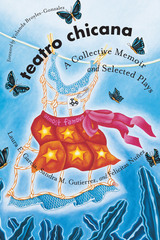 Teatro Chicana: A Collective Memoir and Selected Plays
Edited by Laura E. Garcia, Sandra M. Gutierrez, and Felicitas Nuñez
University of Texas Press, 2008 Winner, Susan Koppelman Award, Best Edited Volume in Women's Studies in Popular and American Culture, 2008 The 1970s and 1980s saw the awakening of social awareness and political activism in Mexican-American communities. In San Diego, a group of Chicana women participated in a political theatre group whose plays addressed social, gender, and political issues of the working class and the Chicano Movement. In this collective memoir, seventeen women who were a part of Teatro de las Chicanas (later known as Teatro Laboral and Teatro Raíces) come together to share why they joined the theatre and how it transformed their lives. Teatro Chicana tells the story of this troupe through chapters featuring the history and present-day story of each of the main actors and writers, as well as excerpts from the group's materials and seven of their original short scripts.
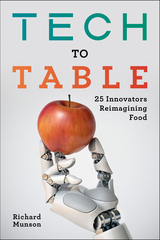 Tech to Table: 25 Innovators Reimagining Food
Richard Munson
Island Press, 2021 Imagine eating a burger grown in a laboratory, a strawberry picked by a robot, or a pastry created with a 3-D printer. You would never taste the difference, but these technologies might just save your health and the planet’s. Today, landmark advances in computing, engineering, and medicine are driving solutions to the biggest problems created by industrialized food.
Tech to Table introduces readers to twenty-five of the most creative entrepreneurs advancing these solutions. They come from various places and professions, identities and backgrounds. But they share an outsider’s perspective and an idealistic, sometimes aggressive, ambition to rethink the food system.
Reinvention is desperately needed. Under Big Ag, pollution, climate change, animal cruelty, hunger, and obesity have festered, and despite decades of effort, organic farming accounts for less than one percent of US croplands. Entrepreneurs represent a new path, one where disruptive technology helps people and the environment. These innovations include supplements to lower the methane in cattle belches, drones that monitor irrigation levels in crops, urban warehouses that grow produce year-round, and more.
The pace and breadth of change is astonishing, as investors pump billions of dollars into ag-innovation. Startups are attracting capital and building markets, with the potential to upend conventional agribusiness’s stranglehold on the food system. Not every invention will prosper long-term, but each marks a fundamental change in our approach to feeding a growing population—sustainably.
A revolution in how we grow and eat food is brewing. Munson’s deftly crafted profiles offer a fascinating preview of the coming future of food.
Technè/Technology: Researching Cinema and Media Technologies, their Development, Use and Impact
Annie van den Oever
Amsterdam University Press, 2014 Technè/Technology is the up-to-date critical volume on the theories, philosophies, and debates on technology and their productivity for the fi elds of fi lm and media studies. Comprehensive as well as innovative, it is not organized around a single thesis — except the assertion that technique is a major concern for fi lm and media scholars, whether this is approached in terms of philosophy, techno-aesthetics, semiotics, apparatus theory, (new) fi lm history, media archaeology, the industry or the sensory/cognitive experience.
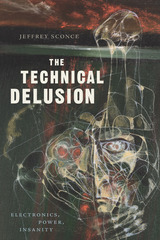 The Technical Delusion: Electronics, Power, Insanity
Jeffrey Sconce
Duke University Press, 2019 Delusions of electronic persecution have been a preeminent symptom of psychosis for over two hundred years. In The Technical Delusion Jeffrey Sconce traces the history and continuing proliferation of this phenomenon from its origins in Enlightenment anatomy to our era of global interconnectivity. While psychiatrists have typically dismissed such delusions of electronic control as arbitrary or as mere reflections of modern life, Sconce demonstrates a more complex and interdependent history of electronics, power, and insanity. Drawing on a wide array of psychological case studies, literature, court cases, and popular media, Sconce analyzes the material and social processes that have shaped historical delusions of electronic contamination, implantation, telepathy, surveillance, and immersion. From the age of telegraphy to contemporary digitality, the media emerged within such delusions to become the privileged site for imagining the merger of electronic and political power, serving as a paranoid conduit between the body and the body politic. Looking to the future, Sconce argues that this symptom will become increasingly difficult to isolate, especially as remote and often secretive powers work to further integrate bodies, electronics, and information.
Technical History of the Beginnings of Radar
S.S. Swords
The Institution of Engineering and Technology, 1986 Radar has become an essential factor in air and sea travel, has affected all areas of military science and, most important of all perhaps, has considerably influenced the progress of electronic engineering.
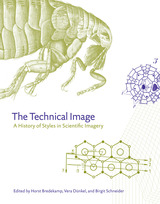 The Technical Image: A History of Styles in Scientific Imagery
Edited by Horst Bredekamp, Vera Dünkel, and Birgit Schneider
University of Chicago Press, 2015 In science and technology, the images used to depict ideas, data, and reactions can be as striking and explosive as the concepts and processes they embody—both works of art and generative forces in their own right. Drawing on a close dialogue between the histories of art, science, and technology, The Technical Image explores these images not as mere illustrations or examples, but as productive agents and distinctive, multilayered elements of the process of generating knowledge. Using beautifully reproduced visuals, this book not only reveals how scientific images play a constructive role in shaping the findings and insights they illustrate, but also—however mechanical or detached from individual researchers’ choices their appearances may be—how they come to embody the styles of a period, a mindset, a research collective, or a device.
Opening with a set of key questions about artistic representation in science, technology, and medicine, The Technical Image then investigates historical case studies focusing on specific images, such as James Watson’s models of genes, drawings of Darwin’s finches, and images of early modern musical automata. These case studies in turn are used to illustrate broad themes ranging from “Digital Images” to “Objectivity and Evidence” and to define and elaborate upon fundamental terms in the field. Taken as a whole, this collection will provide analytical tools for the interpretation and application of scientific and technological imagery.
Technical Knowledge in American Culture: Science, Technology, and Medicine Since the Early 1800s
Edited by Hamilton Cravens, Alan I Marcus, and David M. Katzman
University of Alabama Press, 1996 Addresses the relationships between what modern-day experts say to each other and to their constituencies
Technical Knowledge in American Culture addresses the relationships between what modern-day experts say to each other and to their constituencies and whether what they say and do relates to the larger culture, society, and era. These essays challenge the social impact model by looking at science, technology, and medicine not as social activities but as intellectual activities.
Technical Knowledge in Early Modern Japan
Erich Pauer
Amsterdam University Press, 2020 Drawing on the papers presented at CEEJA’s* first international conference addressing the long-neglected field relating to the generation, dissemination and application of technical knowledge in Japan from the Edo to the Meiji periods, this volume provides a valuable selection of new research on the subject, from Hashimoto Takehiko’s detailed examination of Tanaka Hisashige’s ‘Myriad Year Clock’, Regine Mathias’s paper on mining and smelting, and Erich Pauer’s overview of Japanese technical books in the pre-modern era, to Suzuki Jun’s detailed account of boiler-making in late nineteenth-century Japan. * Centre Européen d’Études Japonaises d’Alsace, 2017
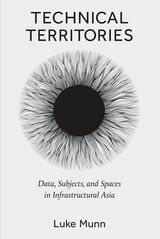 Technical Territories: Data, Subjects, and Spaces in Infrastructural Asia
Luke Munn
University of Michigan Press, 2023 Territory is shifting. No longer defined by the dotted line of the border or the national footprint of soil, today’s territories are enacted through data infrastructures. From subsea cables to server halls, these infrastructures underpin new forms of governance, shaping subjects and their everyday lives. Technical Territories moves from masked protestors in Hong Kong to asylum-seekers in Christmas Island and sand miners in Singapore, exploring how these territories are both political and visceral, altering the experience of their inhabitants.
Infrastructures have now become geopolitical, strategic investments that advance national visions, extend influence, and trigger trade wars. Yet at the same time, these technologies also challenge sovereignty as a bounded container, enacting a more distributed and decoupled form of governance. Such “technical territories” construct new zones where subjects are assembled, rights are undermined, labor is coordinated, and capital is extracted. The stable line of the border is replaced by more fluid configurations of power. Luke Munn stages an interdisciplinary intervention over six chapters, drawing upon a wide range of literature from technical documents and activist accounts, and bringing insights from media studies, migration studies, political theory, and cultural and social studies to bear on these new sociotechnical conditions.
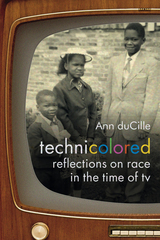 Technicolored: Reflections on Race in the Time of TV
Ann duCille
Duke University Press, 2018 From early sitcoms such as I Love Lucy to contemporary prime-time dramas like Scandal and How to Get Away with Murder, African Americans on television have too often been asked to portray tired stereotypes of blacks as villains, vixens, victims, and disposable minorities. In Technicolored black feminist critic Ann duCille combines cultural critique with personal reflections on growing up with the new medium of TV to examine how televisual representations of African Americans have changed over the last sixty years. Whether explaining how watching Shirley Temple led her to question her own self-worth or how televisual representation functions as a form of racial profiling, duCille traces the real-life social and political repercussions of the portrayal and presence of African Americans on television. Neither a conventional memoir nor a traditional media study, Technicolored offers one lifelong television watcher's careful, personal, and timely analysis of how television continues to shape notions of race in the American imagination.
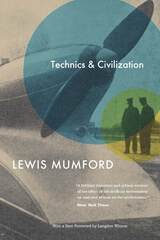 Technics and Civilization
Lewis Mumford
University of Chicago Press, 2010 Technics and Civilization first presented its compelling history of the machine and critical study of its effects on civilization in 1934—before television, the personal computer, and the Internet even appeared on our periphery. Drawing upon art, science, philosophy, and the history of culture, Lewis Mumford explained the origin of the machine age and traced its social results, asserting that the development of modern technology had its roots in the Middle Ages rather than the Industrial Revolution. Mumford sagely argued that it was the moral, economic, and political choices we made, not the machines that we used, that determined our then industrially driven economy. Equal parts powerful history and polemic criticism, Technics and Civilization was the first comprehensive attempt in English to portray the development of the machine age over the last thousand years—and to predict the pull the technological still holds over us today. “The questions posed in the first paragraph of Technics and Civilization still deserve our attention, nearly three quarters of a century after they were written.”—Journal of Technology and Culture
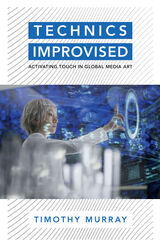 Technics Improvised: Activating Touch in Global Media Art
Timothy Murray
University of Minnesota Press, 2022 Seeing new media art as an entry point for better understanding of technology and worldmaking futures
In this challenging work, a leading authority on new media art examines that curatorial and aesthetic landscape to explore how art resists and rewires the political and economic structures that govern technology. How do inventive combinations of artistic and theoretical improvisation counter the extent to which media art remains at risk, not just from the quarantines of a global pandemic but also from the very viral and material conditions of technology? How does global media art speak back to the corporate closures of digital euphoria as clothed in strategies of digital surveillance, ecological deprivation, and planned obsolescence? In Technics Improvised, Timothy Murray asks these questions and more. At the intersection of global media art, curatorial practice, tactical media, and philosophy, Murray reads a wide range of creative performances and critical texts that envelop artistic and digital materials in unstable, political relations of touch, body, archive, exhibition, and technology. From video to net art and interactive performance, he considers both canonical and unheralded examples of activist technics that disturb the hegemony of biopolitical/digital networks by staging the very touch of the unsettling discourse erupting from within. In the process, critical dialogues emerge between a wide range of artists and theorists, from Hito Steyerl, Ricardo Dominguez, Joan Jonas, Isaac Julien, Ryoji Ikeda, and Shadi Nazarian to Gilles Deleuze, Jean-Luc Nancy, Elizabeth Povinelli, Jean-François Lyotard, Erin Manning, Achille Mbembe, and Samuel Weber. Brilliantly conceived and argued and eloquently written, Technics Improvised points the way to how artistic and theoretical practice can seize on the improvisational accidents of technics to activate creativity, thought, and politics anew.
Technics: Media in the Digital Age
Nicholas Baer
Amsterdam University Press, 2024 Featuring 28 leading international media scholars, Technics rethinks technology for the contemporary digital era, with cutting-edge theoretical, historiographical, and methodological interventions. The volume’s contributors explore the ideas of Walter Benjamin, Ursula Le Guin, Bernhard Siegert, Gilbert Simondon, and Sylvia Wynter in conjunction with urgent questions concerning algorithmic media, digital infrastructures, generative AI, and geoengineering. An expansive collection of writings on media technologies in the digital age, Technics is an essential resource for students and scholars of film and media studies, digital humanities, science and technology studies, and the philosophy of technology.
 The Technique of Child Psychoanalysis: Discussions with Anna Freud
Joseph Sandler, Hansi Kennedy, and Robert L. Tyson
Harvard University Press This book distills the essence of child psychoanalysis from the practice and thought of its founder Anna Freud, who for over 50 years has been at the forefront of this controversial field. Children are the most refractory of all subjects to treat analytically. Here, for the first time, is a primer on the difficult technique as practiced at the Hampstead Clinic in London, which was founded by Anna Freud and is today the leading child analytic center in the world. She and her colleagues expose their wealth of experience to systematic review, which yields up rich insights not only into child psychoanalysis and psychotherapy but also into basic child development. In addition, their findings have relevance to the understanding of emotional disturbance at all ages.
The book follows the treatment situation through all its stages, from the first session to termination and follow-up. It focuses on the interaction between therapist and child in the treatment room, illustrating the points with copious clinical vignettes. One point examined is the structure of treatment with respect to such matters as scheduling sessions and handling interruptions. Another element that comes under scrutiny is the development of the child's relationship to the therapist, which subsumes such factors as establishing an alliance, transference, and resistance. The child's repertoire of expressions, both verbal and nonverbal, is explored, as is the therapist's armamentarium of interpretations and interventions. Woven throughout the description of these elements is incisive commentary by Anna Freud. Her commonsense approach gives the book unique value, lifting it to a rare level of human wisdom.
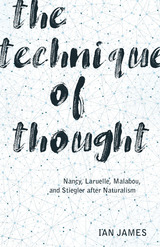 The Technique of Thought: Nancy, Laruelle, Malabou, and Stiegler after Naturalism
Ian James
University of Minnesota Press, 2019 Interrogating the work of four contemporary French philosophers to rethink philosophy’s relationship to science and science’s relationship to reality The Technique of Thought explores the relationship between philosophy and science as articulated in the work of four contemporary French thinkers—Jean-Luc Nancy, François Laruelle, Catherine Malabou, and Bernard Stiegler. Situating their writings within both contemporary scientific debates and the philosophy of science, Ian James elaborates a philosophical naturalism that is notably distinct from the Anglo-American tradition. The naturalism James proposes also diverges decisively from the ways in which continental philosophy has previously engaged with the sciences. He explores the technical procedures and discursive methods used by each of the four thinkers as distinct “techniques of thought” that approach scientific understanding and knowledge experimentally. Moving beyond debates about the constructed nature of scientific knowledge, The Technique of Thought argues for a strong, variably configured, and entirely novel scientific realism. By bringing together post-phenomenological perspectives concerning individual or collective consciousness and first-person qualitative experience with science’s focus on objective and third-person quantitative knowledge, James tracks the emergence of a new image of the sciences and of scientific practice. Stripped of aspirations toward total mastery of the universe or a “grand theory of everything,” this renewed scientific worldview, along with the simultaneous reconfiguration of philosophy’s relationship to science, opens up new ways of interrogating immanent reality.
Techniques and Technologies in Electrical Stimulation for Neuromuscular Rehabilitation
Ian Swain
The Institution of Engineering and Technology, 2025 In its simplest form, electrical stimulation is the application of electrical impulses to nerves via electrodes placed over the nerve or muscle or implanted within the body. The aim is to evoke a muscle contraction. People may not be able to activate their own muscles sufficiently to execute effective movement due to damage to the nervous system preventing the signals from the brain reaching the muscles, for example, after a stroke or spinal cord injury, or due to disuse, often because of pain. Electrical stimulation can be used to restore or improve impaired function by initiating or complementing muscle activity. Stimulation can be used either to provide exercise and so improve strength and endurance or timed to a physical activity such as walking to improve quality of movement and function.
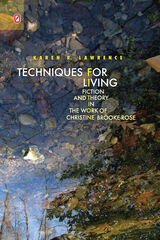 Techniques for Living: Fiction and Theory in the Work of Christine Brooke-Rose
Karen R. Lawrence
Ohio State University Press, 2010 Christine Brooke-Rose is a writer, critic, and narrative theorist whose extraordinarily varied body of work tests the relationship between twentieth-century theory and fiction in unparalleled ways. As they rupture “the relics of nineteenth-century ideologies,” Brooke-Rose’s fictional experiments offer new ways to theorize life and formulate conduct in the new world orders of the twentieth and twenty-first centuries. Specifically addressing the loss of our ability to differentiate reality from what she calls “the unreal,” her novels mime the various “deaths” and absences described in contemporary literary theory, registering these absences technically, ontologically, and emotionally in linguistic and grammatical “constraints.” Rather than melancholy or self-enclosed exercises, however, her writing draws creative vitality out of the loss and limitation it examines. Deploying twentieth-century discourses drawn from technology, literary theory, astronomy, evolutionary biology, and popular culture, her vital, often humorous, fictions offer survival strategies for the genre of the novel. They offer new forms for telling the human story within the unreality of contemporary life. In Techniques for Living: Fiction and Theory in the Work of Christine Brooke-Rose, Karen R. Lawrence explains how Brooke-Rose’s career invites revision of contemporary literary histories and theories of postmodernism. With her highly original narrative forms, Brooke-Rose significantly contributes to the radical evolution of narrative in modernism’s wake. In its singular focus on the lively and prolific experiments of this writer/critic/theorist, Techniques for Living lays the groundwork for further challenges to our generalized versions of postmodernism, as it also provides a fascinating reading of a highly original writer.
 Techniques for Pollination Biologists
Carol A. Kearns
University Press of Colorado, 1993 Techniques for Pollination Biologists is the first book to incorporate all techniques published in the pollination literature as well as unpublished methods compiled from practicing pollination biologists. The bibliography includes 1,200 references from more than 200 journals, plus books and previously unpublished materials. Appendices list sources for all the equipment and chemicals needed. This book presents techniques such as fluorescence microscopy to examine pollen tubes, high-pressure liquid chromatography for nectar analysis, and using particle counters to count pollen grains and nuclear magnetic resonance for floral odor analysis. In addition to these sophisticated methods, basic techniques are described for labeling plants, manipulating flowers, marking or excluding, and designing simple but elegant experiments with small budgets. The book also examines potential pitfalls for pollination studies and offers cautionary advice about designing and implementing different types of pollination experiments.
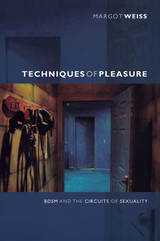 Techniques of Pleasure: BDSM and the Circuits of Sexuality
Margot Weiss
Duke University Press, 2012 Techniques of Pleasure is a vivid portrayal of the San Francisco Bay Area’s pansexual BDSM (SM) community. Margot Weiss conducted ethnographic research at dungeon play parties and at workshops on bondage, role play, and flogging, and she interviewed more than sixty SM practitioners. She describes a scene devoted to a form of erotic play organized around technique, rules and regulations, consumerism, and self-mastery. Challenging the notion that SM is inherently transgressive, Weiss links the development of commodity-oriented sexual communities and the expanding market for sex toys to the eroticization of gendered, racialized, and national inequalities. She analyzes the politics of BDSM’s spectacular performances, including those that dramatize heterosexual male dominance, slave auctions, and US imperialism, and contends that the SM scene is not a “safe space” separate from real-world inequality. It depends, like all sexual desire, on social hierarchies. Based on this analysis, Weiss theorizes late-capitalist sexuality as a circuit—one connecting the promise of new emancipatory pleasures to the reproduction of raced and gendered social norms.
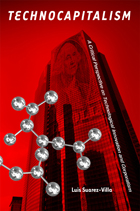 Technocapitalism: A Critical Perspective on Technological Innovation and Corporatism
Luis Suarez-Villa
Temple University Press, 2012 A new version of capitalism, grounded in technology and science, is spawning new forms of corporate power and organization that will have major implications for the twenty-first century. Technological creativity is thereby turned into a commodity in new corporate regimes that are primarily oriented toward research and intellectual appropriation. This phenomenon is likely to have major social, economic, and political consequences, as the new corporatism becomes ever more intrusive and rapacious through its control over technology and innovation.
In his provocative book Technocapitalism, Luis Suarez-Villa addresses this phenomenon from the perspective of radical political economy and social criticism. Grounded in the premise that relations of power influence how human creativity and technology are exploited by the new corporatism, the author argues that new forms of democratic participation and resistance are needed, if the social pathologies created by this new version of capitalism are to be checked.
Considering the new sectors affected by technocapitalism, such as biotechnology, nanotechnology, bioinformatics, and genomics, Suarez-Villa deciphers the common threads of power and organization that drive their corporatization. These new sectors, and the corporate apparatus set up to extract profit and power through them, are imposing standards, creating business models, molding social governance, and influencing social relations at all levels. The new reality they create is likely to affect most every aspect of human existence, including work, health, life, and nature itself.
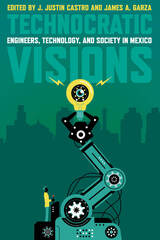 Technocratic Visions: Engineers, Technology, and Society in Mexico
J. Justin Castro and James A. Garza
University of Pittsburgh Press, 2022 Technocratic Visions examines the context and societal consequences of technologies, technocratic governance, and development in Mexico, home of the first professional engineering school in the Americas. Contributors focus on the influential role of engineers, especially civil engineers, but also mining engineers, military engineers, architects, and other infrastructural and mechanical technicians. During the mid-nineteenth century, a period of immense upheaval and change domestically and globally, troubled governments attempted to expand and modernize Mexico’s engineering programs while resisting foreign invasion and adapting new Western technologies to existing precolonial and colonial foundations. The Mexican Revolution in 1910 greatly expanded technocratic practices as state agents attempted to control popular unrest and unify disparate communities via science, education, and infrastructure. Within this backdrop of political unrest, Technocratic Visions describes engineering sites as places both praised and protested, where personal, local, national, and global interests combined into new forms of societal creation; and as places that became centers of contests over representation, health, identity, and power. With an eye on contextualizing current problems stemming from Mexico’s historical development, this volume reveals how these transformations were uniquely Mexican and thoroughly global.
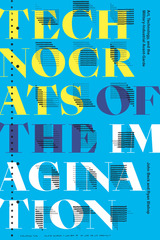 Technocrats of the Imagination: Art, Technology, and the Military-Industrial Avant-Garde
John Beck and Ryan Bishop
Duke University Press, 2020 In Technocrats of the Imagination John Beck and Ryan Bishop explore the collaborations between the American avant-garde art world and the military-industrial complex during the 1960s, in which artists worked with scientists and engineers in universities, private labs, and museums. For artists, designers, and educators working with the likes of Bell Labs, the RAND Corporation, and the Los Angeles County Museum of Art, experiments in art and technology presaged not only a new aesthetic but a new utopian social order based on collective experimentation. In examining these projects' promises and pitfalls and how they have inspired a new generation of collaborative labs populated by artists, engineers, and scientists, Beck and Bishop reveal the connections between the contemporary art world and the militarized lab model of research that has dominated the sciences since the 1950s.
 Technocreep and the Politics of Things Not Seen
Neda Atanasoski and Nassim Parvin, editors
Duke University Press, 2025 New and emerging technologies, especially ones that infiltrate intimate spaces, relations, homes, and bodies, are often referred to as creepy in media and political discourses. In Technocreep and the Politics of Things Not Seen, Neda Atanasoski and Nassim Parvin introduce a feminist theory of creep that they substantiate through critical engagement with smart homes, smart dust, smart desires, and smart forests toward dreams of feminist futures. Contributing authors further illuminate what is otherwise obscured, assumed, or dismissed in characterizations of technology as creepy or creeping. Considering diverse technologies such as border surveillance and China’s credit system to sexcams and home assistants, the volume’s essays and artworks demonstrate that the potentials and pitfalls of artificial intelligence and digital and robotic technologies cannot be assessed through binaries of seeing/being seen, privacy/surveillance, or harmful/useful. Together, their multifaceted and multimodal approach transcends such binaries, accounting for technological relations that exceed sight to include touch, presence, trust, and diverse modes of collectivity. As such, this volume develops creep as a feminist analytic and creative mode on par with technology’s complex entanglement with intimate, local, and global politics.
Contributors. Neda Atanasoski, Katherine Bennett, Iván Chaar López, Sushmita Chatterjee, Hayri Dortdivanlioglu, Sanaz Haghani, Jacob Hagelberg, Jennifer Hamilton, Antonia Hernández, Marjan Khatibi, Tamara Kneese, Erin McElroy, Vernelle A. A. Noel, Jessica Olivares, Nassim Parvin, Beth Semel, Renee Shelby, Tanja Wiehn
Technoculture
Constance Penley
University of Minnesota Press, 1991
Tech-Noir Film: A Theory of the Development of Popular Genres
Emily E. Auger
Intellect Books, 2011 From the postapocalyptic world of Blade Runner to theJames Cameron mega-hit Terminator, tech-noir has emerged as a distinct genre, with roots in both the Promethean myth and the earlier popular traditions of gothic, detective, and science fiction. In this new volume, many well-known film and literary works—including The Matrix, RoboCop, and Mary Shelley’s Frankenstein—are discussed with reference to their relationship to tech-noir and one another. Featuring an extensive, clearly indexed filmography, Tech-Noir Film will be of great interest to anyone wishing to learn more about the development of this new and highly innovative genre.
Technological Change and Management
David W. Ewing
Harvard University Press, 1970 Six leaders of American industry and government analyze the social and economic implications of scientific and technological change. Donald Cook discusses “Technology—Mainspring of History”; Eli Goldston, “The Limits of Technology”; Joseph C. Wilson, “The New Entrepreneur”; Charles E. Thornton, “The Role of Modern Business”; E. G. Woodroofe, “Technology and Business Opportunity for the International Business”; and James E. Webb, “NASA as an Adaptive Organization.”
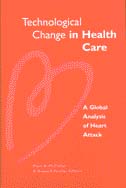 Technological Change in Health Care: A Global Analysis of Heart Attack
Mark B. McClellan and Daniel P. Kessler, Editors
University of Michigan Press, 2002 Evidence from the United States suggests that technological change is a key factor in understanding both medical expenditure growth and recent dramatic improvements in the health of people with serious illnesses. Yet little international research has examined how the causes and consequences of technological change in health care differ worldwide. Seeking to illuminate these issues, this volume documents how use of high-technology treatments for heart attack changed in fifteen developed countries over the 1980s and 1990s. Drawn from the collaborative effort of seventeen research teams in fifteen countries, it provides a cross-country analysis of microdata that illuminates the relationships between public policies toward health care, technology, costs, and health outcomes.
The comparisons presented here confirm that the use of medical technology in treatment for heart attack is strongly related to incentives, and that technological change is an important cause of medical expenditure growth in all developed countries. Each participating research team reviewed the economic and regulatory incentives provided by their country's health system, and major changes in those incentives over the 1980s and 1990s, according to a commonly used framework. Such incentives include: the magnitude of out-of-pocket costs to patients, the generosity of reimbursement to physicians and hospitals, regulation of the use of new technologies or the supply of physicians, regulation of competition, and the structure of hospital ownership. Each team also reviewed how care for heart attacks has changed in their country over the past decade.
The book will be of enormous importance to health economists, medical researchers and epidemiologists, and policymakers.
Mark McClellan is Associate Professor of Economics and of Medicine and, by courtesy, of Health Research and Policy, Stanford University. He is a National Fellow, the Hoover Institution. Daniel P. Kessler is Associate Professor of Economics, Law, and Policy in the Graduate School of Business, Stanford University, and a Research Fellow, the Hoover Institution.
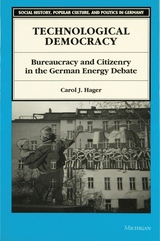 Technological Democracy: Bureaucracy and Citizenry in the German Energy Debate
Carol J. Hager
University of Michigan Press, 1995 What are the prospects for democratic participation in the modern technological state? Is technology a force of emancipation or enslavement? Intellectuals such as Max Weber have prophesied that complex issues would ultimately be decided by technical experts instead of by those who were affected or their political representatives—and that politics would give way to technocracy. Technological Democracy explores the connection between environmental and democratizing concerns in Germany, to see what answers environmental groups might provide to the question of the citizen's role in a technological society. The volume explores the ways in which lay citizens can participate in policy decisions of a technical nature, and whether in doing so they can repoliticize and democratize those policy areas that have become the territory of experts. Technological Democracy will be of interest to scholars and students in German history, political science, and sociology.
 The Technological Indian
Ross Bassett
Harvard University Press, 2016 In the late 1800s, Indians seemed to be a people left behind by the Industrial Revolution, dismissed as “not a mechanical race.” Today Indians are among the world’s leaders in engineering and technology. In this international history spanning nearly 150 years, Ross Bassett—drawing on a unique database of every Indian to graduate from the Massachusetts Institute of Technology between its founding and 2000—charts their ascent to the pinnacle of high-tech professions.
As a group of Indians sought a way forward for their country, they saw a future in technology. Bassett examines the tensions and surprising congruences between this technological vision and Mahatma Gandhi’s nonindustrial modernity. India’s first prime minister, Jawaharlal Nehru, sought to use MIT-trained engineers to build an India where the government controlled technology for the benefit of the people. In the private sector, Indian business families sent their sons to MIT, while MIT graduates established India’s information technology industry.
By the 1960s, students from the Indian Institutes of Technology (modeled on MIT) were drawn to the United States for graduate training, and many of them stayed, as prominent industrialists, academics, and entrepreneurs. The MIT-educated Indian engineer became an integral part of a global system of technology-based capitalism and focused less on India and its problems—a technological Indian created at the expense of a technological India.
Technological Perspectives on Behavioral Change
Michael Brian Schiffer
University of Arizona Press, 1992 Human societies have always been characterized by a dependence on artifacts, from prehistoric stone tools to modern electronic devices. Technology responds to and affects virtually all human behavior; yet the interdependence of behavior and artifacts has never been studied intensively. Archaeologist Schiffer now draws on his discipline's familiarity with artifacts--and the processes of change they reveal--to offer new insight into the study of behavioral change. Drawing on case studies that deal with changes in architecture, ceramics and electronic technology, he emphasizes the central idea that the explanations of change must focus on the nexus of behavior and artifacts in the context of activities.
Technological Shortcuts to Social Change
Amitai Etzioni
Russell Sage Foundation, 1973 Evaluates a technological approach to social change which seeks to cure society's ills by dealing with its symptoms, rather than root causes. It examines four such technological shortcuts in terms of their relevance to specific social problems: methadone in controlling heroin addiction; antabuse in treating alcoholism; the breath analyzer in highway safety; and gun control in reducing crime. The authors seek solutions which do not require large amounts of new resources or planning, and will accelerate the pace of social change. They indicate that technological handling of such problems may be the answer.
 Technological Turf Wars: A Case Study of the Computer Antivirus Industry
Jessica Johnston
Temple University Press, 2008 In Technological Turf Wars, Jessica Johnston analyzes the tensions and political dilemmas that coexist in the interrelationship among science, technology and society. Illustrating how computer security is as concerned with social relationships as it is with technology, Johnston provides an illuminating ethnography that considers corporate culture and the workplace environment of the antivirus industry. Using a qualitative, interdisciplinary approach, which combines organizational and security studies with critical and social analysis of science and technology, Johnston questions the motivations, contradictions and negotiations of antivirus professionals. She examines the tensions between the service ethics and profit motives—does the industry release viruses to generate demand for antivirus software?—and considers the dynamics within companies by looking at facets such as gender bias and power politics. Technological Turf Wars is an informed, enlightened and entertaining view of how the production of computer security technology is fraught with social issues.
Technological Visions: Hopes And Fears That Shape New Technologies
Marita Sturken
Temple University Press, 2004 For as long as people have developed new technologies, there has been debate over the purposes, shape, and potential for their use. In this exciting collection, a range of contributors, including Sherry Turkle, Lynn Spigel, John Perry Barlow, Langdon Winner, David Nye, and Lord Asa Briggs, discuss the visions that have shaped "new" technologies and the cultural implications of technological adaptation. Focusing on issues such as the nature of prediction, community, citizenship, consumption, and the nation, as well as the metaphors that have shaped public debates about technology, the authors examine innovations past and present, from the telegraph and the portable television to the Internet, to better understand how our visions and imagination have shaped the meaning and use of technology.
Technologies and Techniques in Gait Analysis: Past, present and future
Nachiappan Chockalingam
The Institution of Engineering and Technology, 2022 Gait analysis is the study of the walking or running pattern of an individual. This can include spatial and temporal measurements such as step length, stride length and speed along with angular measurements of various joints and the interplay between various parts like the foot, hip, pelvis or spine when walking. Gait analysis can be used to assess clinical conditions and design effective rehabilitation; for example, following limb injury or amputation, or other disorders such as a stroke or Parkinson's diagnosis. It can be used to influence intervention decisions, such as whether a patient should undergo surgery, further physiotherapy, or begin a particular treatment regime. Gait analysis can also be used in sports science to monitor and review performance and technique.
Technologies for Healthcare 4.0: From AI and IoT to blockchain
Karthik Ramamurthy
The Institution of Engineering and Technology, 2023 There are a growing number of challenges in handling medical data in order to provide an effective healthcare service in real-time. Bridging the gap between patient expectations and their experiences needs effective collaboration and connectivity across the healthcare ecosystem. The success of joined-up care relies on patient data being shared between all active stakeholders, including hospitals, outreach workers, and GPs. All these needs and challenges pave the way for the next trend of development in healthcare - healthcare 4.0.
Technologies for the Electrification of Land and Sea Transportation
Muhyaddin J.H. Rawa
The Institution of Engineering and Technology, 2025 Despite the ongoing effects of climate change, large swaths of transport vehicles are still being powered with fossil fuels, generating enormous amounts of greenhouse gas emissions. Changing our transport technology is crucial to ensure a transition away from fossil fuels and toward renewable energy, with green electricity acting as the major transmission medium. With the development of innovative storage and propulsion, combined with real-time energy management, significant changes are feasible in the shipping, automotive, and aeronautics sectors.
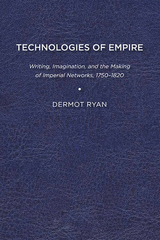 Technologies of Empire: Writing, Imagination, and the Making of Imperial Networks, 1750–1820
Dermot Ryan
University of Delaware Press, 2013 Technologies of Empire looks at the ways in which writers of the long eighteenth century treat writing and imagination as technologies that can produce rather than merely portray empire. Authors ranging from Adam Smith to William Wordsworth consider writing not as part of a larger logic of orientalism that represents non-European subjects and spaces in fixed ways, but as a dynamic technology that organizes these subjects and transforms these spaces. Technologies of Empire reads the imagination as an instrument that works in tandem with writing, expanding and consolidating the networks of empire. Through readings across a variety of genres, ranging from Smith’s The Wealth of Nations and Edmund Burke’s Reflections on the Revolution in France to Maria Edgeworth’s Irish fiction and Wordsworth’s epic poetry, this study offers a new account of writing’s role in empire-building and uncovers a genealogy of the romantic imagination that is shot through by the imperatives of imperialism.
Published by University of Delaware Press. Distributed worldwide by Rutgers University Press.
Technologies of Freedom
Ithiel de Sola Pool
Harvard University Press, 1983 How can we preserve free speech in an electronic age? In a masterly synthesis of history, law, and technology, Ithiel de Sola Pool analyzes the confrontation between the regulators of the new communications technology and the First Amendment.
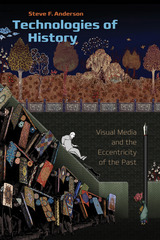 Technologies of History: Visual Media and the Eccentricity of the Past
Steve F. Anderson
Dartmouth College Press, 2011 Technologies of History is an engrossing and innovative consideration of how history is constructed today, exploring our most basic relationship to history and the diverse contributions of visual and computational media to conceptions of the past. Embracing the varieties of history offered by experimental film, television, video games, and digital media, Steve F. Anderson mines the creative and discursive potential of this profane and esoteric historiography. He offers a highly readable and consistently fascinating discussion of historiography in visual media, with an emphasis on alternate or fantastic histories, including Star Trek time travel episodes, fake documentaries, films created from home movies and found footage, and video games about cultural traumas such as the siege at Waco and the assassination of President John F. Kennedy. Examining artifacts from the most commercial Hollywood product to the modernist avant-garde, this bold and ambitious polemic seeks to address historians, media scholars, and general readers alike, encouraging all to recognize, engage with, and perhaps even learn from these heterodox histories and the powerful sway they hold over our historical consciousness.
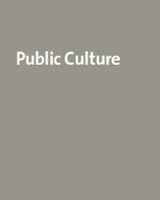 Technologies of Public Persuasion: An Accidental Issue, Volume 15
Dilip Parameshwar Gaonkar and Elizabeth A. Povinelli, eds.
Duke University Press As technology increasingly dominates the public sphere , Technologies of Public Persuasion: An Accidental Issue offers richly descriptive examples of how technologically influenced forms and artifacts of communication effect transformations in the self-understandings of publics and subjects. This special issue of Public Culture exposes readers to new discursive genres and practices, linking literary cultural methodologies and theories to social analysis. The contributors explore topics ranging from the use of cell phones by middle-class Filipinos in the civilian-backed overthrow of President Joseph Estrada to a media reported "hint" from Alan Greenspan that impacted and altered economic reality through speculation. An essay investigates the politics surrounding the formation and use of Indonesian as a self-consciously modern language designed to reconstitute the social and political identities of its speakers. A photo-essay depicts graffiti on abandoned school buildings as a communicative medium. "Crimes of Substitution: Detection in the Late Soviet Society" looks at late-Soviet detective fiction, censorship strategies, and Soviet semiotics to show how Soviet citizens subverted dictated modes of behavior and challenged the symbolic order of Soviet society. One contributor examines how performance and ethnolinguistic practices become techniques for spatially and socially locating identity. Contributors. Alberta Arthurs, Dilip Parameshwar Gaonkar, Michael Kaplan, Webb Keane, Patrick Mullen, Serguei Oushakine, Elizabeth A. Povinelli, Vicente L. Rafael, Christopher Schneider, Michael Silverstein, Amanda Weidman
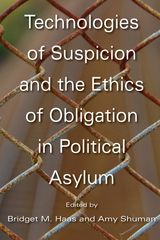 Technologies of Suspicion and the Ethics of Obligation in Political Asylum
Bridget M. Haas
Ohio University Press, 2019 Across the globe, migration has been met with intensifying modes of criminalization and securitization, and claims for political asylum are increasingly met with suspicion. Asylum seekers have become the focus of global debates surrounding humanitarian obligations, on the one hand, and concerns surrounding national security and border control, on the other. In Technologies of Suspicion and the Ethics of Obligation in Political Asylum, contributors provide fine-tuned analyses of political asylum systems and the adjudication of asylum claims across a range of sociocultural and geopolitical contexts. The contributors to this timely volume, drawing on a variety of theoretical perspectives, offer critical insights into the processes by which tensions between humanitarianism and security are negotiated at the local level, often with negative consequences for asylum seekers. By investigating how a politics of suspicion within asylum systems is enacted in everyday practices and interactions, the authors illustrate how asylum seekers are often produced as suspicious subjects by the very systems to which they appeal for protection. Contributors: Ilil Benjamin, Carol Bohmer, Nadia El-Shaarawi, Bridget M. Haas, John Beard Haviland, Marco Jacquemet, Benjamin N. Lawrance, Rachel Lewis, Sara McKinnon, Amy Shuman, Charles Watters
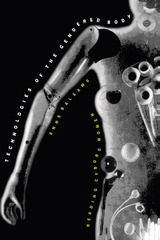 Technologies of the Gendered Body: Reading Cyborg Women
Anne Balsamo
Duke University Press, 1996 This book takes the process of "reading the body" into the fields at the forefront of culture—the vast spaces mapped by science and technology—to show that the body in high-tech is as gendered as ever. From female body building to virtual reality, from cosmetic surgery to cyberpunk, from reproductive medicine to public health policies to TV science programs, Anne Balsamo articulates the key issues concerning the status of the body for feminist cultural studies in a postmodern world.
Technologies of the Gendered Body combines close readings of popular texts—such as Margaret Atwood’s novel The Handmaid’s Tale, the movie Pumping Iron II: The Women, cyberpunk magazines, and mass media—with analyses of medical literature, public policy documents, and specific technological practices. Balsamo describes the ways in which certain biotechnologies are ideologically shaped by gender considerations and other beliefs about race, physical abilities, and economic and legal status. She presents a view of the conceptual system that structures individuals’ access to and participation in these technologies, as well as an overview of individuals’ rights and responsibilities in this sometimes baffling area. Examining the ways in which the body is gendered in its interactions with new technologies of corporeality, Technologies of the Gendered Body counters the claim that in our scientific culture the material body has become obsolete. With ample evidence that the techno-body is always gendered and marked by race, this book sets the stage for a renewed feminist engagement with contemporary technological narratives.
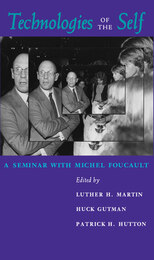 Technologies of the Self: A Seminar with Michel Foucault
Luther H. Martin
University of Massachusetts Press, 1988 Shortly before his death in 1984, Michel Foucault spoke of an idea for a new book on "technologies of the self." He described it as "composed of different papers about the self...,about the role of reading and writing in constituting the self... and so on." The book Foucault envisioned was based on a faculty seminar on "Technologies of the Self," originally presented at the University of Vermont in the fall of 1982. This volume is a partial record of that seminar.
In many ways, Foucault's project on the self was the logical conclusion to his historical inquiry over twenty-five years into insanity, deviancy, criminality, and sexuality. Because Foucault died before he completed the revisions of his seminar presentations, this volume includes a careful transcription instead...as a prolegomenon to that unfinished task.
Foucault was a French philosopher, historian of ideas, social theorist, philologist and literary critic.
This volume was edited by Luther H. Martin, Huck Gutman, and Patrick H. Hutton.
 Technologies without Boundaries: On Telecommunications in a Global Age
Ithiel de Sola Pool
Harvard University Press, 1990 At the time of his death in 1984, Ithiel de Sola Pool had completed a rough draft of a manuscript he had been working on for years. It contained his vision of a new world resulting from the social and political consequences of communications technology. Edited into an elegant synthesis of technology, history, politics, and economics by his friend and fellow scholar, Eli Noam, this is the intellectual legacy of one of our century's wisest social critics.
In the book Pool foresees dramatic changes that will revolutionize culture and society as much as printing did five centuries ago. Because distance no longer places a significant economic burden on communications, he predicts complex changes in the spatial patterns of human settlements. People will not simply move away from cities and disperse, but will cluster together in new ways, for different reasons, and in different locations. The increasingly lower cost of long distance communication will also cause political movements that formerly would have been confined to their country of origin to spill over national boundaries, creating threats to national sovereignty. Furthermore, the ability to customize messages and target them to specific audiences could also work to undermine social and political cohesion. What will it mean to the effective functioning of democratic societies, Pool asks, if the influence of the mass media weakens and citizens can no longer agree on a common agenda of problems, let alone solutions to those problems? Pool also shows how the coming convergence of print and electronic media could lead, inadvertently, to the erosion of the system of free public discourse that we value so highly.
Technologies without Boundaries is a book of great social and political import, accessible—and necessary—to thoughtful readers living in this century and beyond.
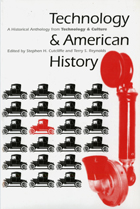 Technology and American History: A Historical Anthology from Technology and Culture
Edited by Stephen H. Cutcliffe and Terry S. Reynolds
University of Chicago Press, 1997 Technology and American History explores the technological dimension of American life from the birth of American industry in the late eighteenth century to the massive industrial systems of the late twentieth century.
Emphasizing a societal context for technology, this carefully organized collection demonstrates both the manner in which cultural, political, and economic forces shape innovation, and the ways that technology has influenced society and shaped its values. Individual essays explore the importance of textile manufacturing in American industrialization, the role of the federal government in regulating new modes of transport, the development of interchangeable parts in production, the process of innovation, the notion of technological systems, and the relationship between technological change and work in the factory, on the farm, and in the home.
The essays were selected to be accessible to both the general reader and the undergraduate student.
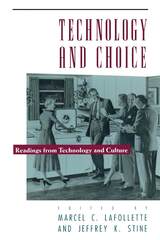 Technology and Choice: Readings from Technology and Culture
Edited by Marcel C. LaFollette and Jeffrey K. Stine
University of Chicago Press, 1991 Innovation - the imaginative attempt to introduce something new or to solve some problem - smashes routine and demands choice, even if only the choice to retain the status quo. This collection of fourteen essays provides a spectrum of historical perspectives on how, when, or why, individuals, societies, governments, and industries have made choices regarding the use of technologies. Through historical accounts that span centuries and national boundaries, exploring the complexity of a nuclear power plant and the apparent simplicity of an electrical plug, the contributors to this volume dramatically illustrate the push and pull between technology and society. General topics addressed include: - Regulation of private industry
- Social acceptance of commercial innovation
- Negative perceptions of the "Technological Age"
- Cultural and artistic features of technology
Provocative and accessible, this collection will serve both students and faculty in history, sociology, and public policy, as well as in history and philosophy of science and technology. These essays were originally published in the journal Technology and Culture
 Technology and Desire: The Transgressive Art of Moving Images
Edited by Rania Gaafar and Martin Schulz
Intellect Books, 2014 The spectral realm at the boundaries of images incessantly reveals a desire to see beyond the visible and its medium: screens, frames, public displays, and projection sites in an art context. The impact of new media on art and film has influenced the material histories and performances (be they in theory or practice) of images across the disciplines. Digital technologies have not only shaped post-cinematic media cultures and visual epistemologies, but they are behind a growing shift towards a new realism in theory, art, film, and in the art of the moving image in particular. Technology and Desire examines the performative ontologies of moving images across the genealogies of media and their aesthetic agency in contemporary media and video art, CGI, painting, video games, and installations. Drawing on cultural studies, media and film theory as well as art history to provide exemplary evidence of this shift, this book has as its central theme the question of whether images are predicated upon transgressing the boundaries of their framing—and whether in the course of their existence they develop a life of their own.
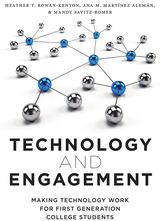 Technology and Engagement: Making Technology Work for First Generation College Students
Rowan-Kenyon, Heather T.
Rutgers University Press, 2018 Winner of the 2018 Association for the Study of Higher Education Outstanding Book Award
Technology and Engagement is based on a four-year study of how first generation college students use social media, aimed at improving their transition to and engagement with their university. Through web technology, including social media sites, students were better able to maintain close ties with family and friends from home, as well as engage more with social and academic programs at their university. This ‘ecology of transition’ was important in keeping the students focused on why they were in college, and helped them become more integrated into the university setting. By showing the gains in campus capital these first-generation college students obtained through social media, the authors offer concrete suggestions for how other universities and college-retention programs can utilize the findings to increase their own retention of first-generation college students.
Technology and Film Scholarship: Experience, Study, Theory
Edited by Santiago Hidalgo
Amsterdam University Press, 2018 This volume brings together a wide range of research on the ways in which technological innovations have established new and changing conditions for the experience, study and theorization of film. Drawn from the IMPACT film conference (The Impact of Technological Innovations on the Historiography and Theory of Cinema) held in Montreal in 2011, the book includes contributions from such leading figures in the field as Tom Gunning, Charles Musser, Jan Olsson and Vinzenz Hediger.
 Technology and Investment: The Prewar Japanese Chemical Industry
Barbara Molony
Harvard University Press The chemical industry was Japan's first "high-tech" industry, and its companies the most important examples of a noteworthy business structure in the prewar period, the so-called "new zaibatsu."
Molony deals with one branch of the chemical industry--electrochemicals--with shorter descriptions of related branches. At the hear of the book is the story of Noguchi Jun, founder of Japan Nitrogenous Fertilizers (Nippon Chisso Hiryō) and one of Japan's best known twentieth-century entrepreneurs. Noguchi's firm developed from a fertilizer company to a multifaceted company producing a wide range of technologically sophisticated products while he forged ties with civilian and military leaders in Japan and Korea who controlled access to capital and to the hydroelectricity needed for chemical manufacture. The book also treats the second and third waves of investment and electrochemicals during the 1920s and 1930s.
This study analyzes the nature of prewar Japanese entrepreneurship, the links between technology and investment, the emergence of a class of scientific managers, and the relationship of business strategy to imperialism in the years leading up to World War II.
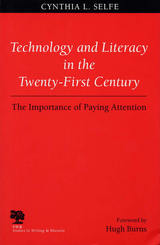 Technology and Literacy in the 21st Century: The Importance of Paying Attention
Cynthia L. Selfe. Foreword by Hugh Burns
Southern Illinois University Press, 1999 Part critique of existing policy and practice, part call-to-action, Technology and Literacy in the Twenty-First Century explores the complex linkage between technology and literacy that has come to characterize American culture and its public educational system at the end of the twentieth century. To provide a specific case study of this complex cultural formation, award-winning educator Cynthia L. Selfe discusses the Technology Literacy Challenge, an official, federally sponsored literacy project begun in 1996 that has changed—at fundamentally important levels—the definition of literacy and the practices recognized as constituting literate behavior in America. Selfe tries to identify the effects of this new literacy agenda, focusing specifically on what she calls "serious and shameful" inequities it fosters in our culture and in the public education system: among them, the continuing presence of racism, poverty, and illiteracy. She describes how the national project to expand technological literacy came about, what effects it has yielded, why the American public has supported this project, and how teachers of English, language arts, and composition have contributed to this project, despite their best intentions. A primary goal of this study is to make teachers of English and composition increasingly aware of the new literacy agenda and to suggest how they might positively influence its shape and future direction, both in the classroom and in the community. This awareness is an integral part of educators' larger professional responsibility to understand the way in which our culture thinks about and values literacy. Perhaps even more important, argues Selfe, this awareness is part of teachers' ethical responsibility to understand how literacy and literacy instruction directly and continually affect the lived experiences of the individuals and families with whom teachers interact.
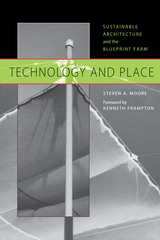 Technology and Place: Sustainable Architecture and the Blueprint Farm
By Steven A. Moore
University of Texas Press, 2001 Developing "sustainable" architectural and agricultural technologies was the intent behind Blueprint Farm, an experimental agricultural project designed to benefit farm workers displaced by the industrialization of agriculture in the Rio Grande Valley of Texas. Yet, despite its promise, the very institutions that created Blueprint Farm terminated the project after just four years (1987-1991). In this book, Steven Moore demonstrates how the various stakeholders' competing definitions of "sustainability," "technology," and "place" ultimately doomed Blueprint Farm. He reconstructs the conflicting interests and goals of the founders, including Jim Hightower and the Texas Department of Agriculture, Laredo Junior College, and the Center for Maximum Potential Building Systems, and shows how, ironically, they unwittingly suppressed the self-determination of the very farm workers the project sought to benefit. From the instructive failure of Blueprint Farm, Moore extracts eight principles for a regenerative architecture, which he calls his "nonmodern manifesto."
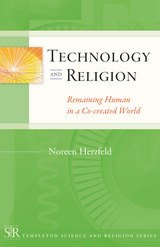 Technology and Religion: Remaining Human Co-created World
Noreen Herzfeld
Templeton Press, 2009 Technology is changing all the time, but does it also have the ability to change us and the way we approach religion and spirituality? In Technology and Religion: Remaining Human in a Co-created World, Noreen Herzfeld examines this and other provocative questions as she provides an accessible and fascinating overview of the relationship between religion and the ever-broadening world of technology. In order to consider fully a topic as wide as technology, Herzfeld approaches the field from three different angles: technologies of the human body—such as genetic engineering, stem cells, cloning, pharmaceutical technologies, mechanical enhancement and cyborgs; technologies of the human mind—like human and artificial intelligence, virtual reality and cyberspace; and technologies of the external environment—such as nanotechnology, genetically modified crops and new agricultural technologies, and energy technology. She takes a similarly broad approach to the field of religion, focusing on how these issues interface with the three Abrahamic traditions of Christianity, Islam, and Judaism. Throughout, readers will find nuanced examinations of the moral and ethical issues surrounding new technologies from the perspectives of these faith traditions.
The result is a multifaceted look at the ongoing dialogue between these two subjects that are not commonly associated with one another. This volume is the third title published in the new Templeton Science and Religion Series.
Technology and the Character of Contemporary Life: A Philosophical Inquiry
Albert Borgmann
University of Chicago Press, 1987 Blending social analysis and philosophy, Albert Borgmann maintains that technology creates a controlling pattern in our lives. This pattern, discernible even in such an inconspicuous action as switching on a stereo, has global effects: it sharply divides life into labor and leisure, it sustains the industrial democracies, and it fosters the view that the earth itself is a technological device. He argues that technology has served us as well in conquering hunger and disease, but that when we turn to it for richer experiences, it leads instead to a life dominated by effortless and thoughtless consumption. Borgmann does not reject technology but calls for public conversation about the nature of the good life. He counsels us to make room in a technological age for matters of ultimate concern—things and practices that engage us in their own right.
 Technology and the Future of Schooling in America
Edited by Stephen T. Kerr
University of Chicago Press, 1996 This volume explores how technology will help shape the future of American education. Rather than focusing on specific technologies, these essays consider the broad impact of technology on educational philosophy, education policy, and the social context of education.
Guiding this volume is the conviction that advances in technology do not necessarily translate into improvements in education even as the basic structure of teaching programs must be changed to fully exploit the educational uses of technology. The contributors argue that technology should be distributed throughout the educational system, not just in wealthy districts; they examine the impact of communications technologies on relationships between teachers and students, parents and children, and men and women; they consider the ways in which new technologies change the dynamics of learning and teaching; and they show how teachers and administrators can tailor technology-based programs to the particular needs of their school or district.
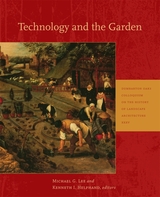 Technology and the Garden
Michael G. Lee
Harvard University Press Technology is the practice and activity of making, as well as the tools that enable that making. It is also the realm of ideas behind those endeavors, the expanse of technical knowledge and expertise. At once material, intellectual, active, and social, technology is the purposeful organization of human effort to alter and shape the environment. Gardens, like other designed landscapes, are products of a range of technologies; their layout, construction, and maintenance would be unthinkable without technology. What are the technologies of garden making, what are the concepts and ideas behind garden technologies, and what is the meaning and experience of those endeavors?
Technology and the Garden examines the shaping and visualization of the landscape; the development of horticultural technologies; the construction of landscape through hydraulics, labor, and infrastructure; and the effect of emerging technologies on the experience of landscape. These essays demonstrate how the techniques of the garden can be hidden or revealed, disguised beneath the earth or celebrated on the surface. How designers have approached technology, in all historical periods and in a diversity of places and cultures, is a central question in landscape studies.
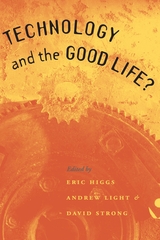 Technology and the Good Life?
Edited by Eric Higgs, Andrew Light, and David Strong
University of Chicago Press, 2000 Can we use technology in the pursuit of a good life, or are we doomed to having our lives organized and our priorities set by the demands of machines and systems? How can philosophy help us to make technology a servant rather than a master?
Technology and the Good Life? uses a careful collective analysis of Albert Borgmann's controversial and influential ideas as a jumping-off point from which to address questions such as these about the role and significance of technology in our lives. Contributors both sympathetic and critical examine Borgmann's work, especially his "device paradigm"; apply his theories to new areas such as film, agriculture, design, and ecological restoration; and consider the place of his thought within philosophy and technology studies more generally.
Because this collection carefully investigates the issues at the heart of how we can take charge of life with technology, it will be a landmark work not just for philosophers of technology but for students and scholars in the many disciplines concerned with science and technology studies.
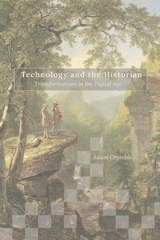 Technology and the Historian: Transformations in the Digital Age
Adam Crymble
University of Illinois Press, 2021 Charting the evolution of practicing digital history Historians have seen their field transformed by the digital age. Research agendas, teaching and learning, scholarly communication, the nature of the archive—all have undergone a sea change that in and of itself constitutes a fascinating digital history. Yet technology's role in the field's development remains a glaring blind spot among digital scholars. Adam Crymble mines private and web archives, social media, and oral histories to show how technology and historians have come together. Using case studies, Crymble merges histories and philosophies of the field, separating issues relevant to historians from activities in the broader digital humanities movement. Key themes include the origin myths of digital historical research; a history of mass digitization of sources; how technology influenced changes in the curriculum; a portrait of the self-learning system that trains historians and the problems with that system; how blogs became a part of outreach and academic writing; and a roadmap for the continuing study of history in the digital era.
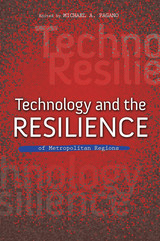 Technology and the Resilience of Metropolitan Regions
Edited by Michael E. Pagano
University of Illinois Press, 2015 Can today's city govern well if its citizens lack modern technology? How important is access to computers for lowering unemployment? What infrastructure does a city have to build in order to attract new business?
In this new collection, Michael A. Pagano curates engagement with such questions by public intellectuals, stakeholders, academics, policy analysts, and citizens. Each essay explores issues related to the impact and opportunities technology provides in government and citizenship, health care, workforce development, service delivery to citizens, and metropolitan growth. As the authors show, rapidly emerging technologies and access to such technologies shape the ways people and institutions interact in the public sphere and private marketplace. The direction of metropolitan growth and development, in turn, depends on access to appropriate technology scaled and informed by the individual, household, and community needs of the region.
Contributors include Randy Blankenhorn, Bénédicte Callan, Jane Fountain, Sandee Kastrul, Karen Mossberger, Dan O'Neil, Michelle Russell, Alfred Tatum, Stephanie Truchan, Darrel West, and Howard Wial.
Technology and the West: A Historical Anthology from Technology and Culture
Edited by Terry S. Reynolds and Stephen H. Cutcliffe
University of Chicago Press, 1997 This broad-ranging anthology provides a condensed overview of technology in Western civilization. Its twenty-one carefully selected articles and overview essays demonstrate the complex relationship between technological and social change from antiquity to the present. Specific topics include the origins of contemporary social and political institutions in the irrigation civilizations of antiquity, technology and the military, popular perceptions of the early industrial revolution in Europe, the difference between invention and innovation, the role of government in the development of technology, the nature of technical expertise, and nuclear power and the environment.
General readers and students will find this collection accessible and engaging.
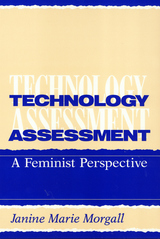 Technology Assessment: A Feminist Perspective
Janine Marie Morgall
Temple University Press, 1993 How well does technology assessment (TA) relate to women's lives? If women are underrepresented in the long-term research and development process that leads to scientific advancements, how can TA understand technology aimed at women? It can't, claims the author of Technology Assessment: A Feminist Perspective. A relative new field, TA examines the social aspect of technology and provides information critical to decision making, policy development, safety standards, and avoiding litigation. Until gender analysis is introduced into all assessments of new technologies, Janine Marie Morgall argues, TA can't evaluate technology's impact upon women. Morgall investigates two areas of technology that affect women's lives: productive (clerical work) and reproductive (health care). Case studies of clerical workers and health care recipients illustrate gender-specify effects of technology ranging from word processors to treatments for infertility. These studies convincingly demonstrate that TA encourages innovations without questioning their effects on women. Issues of dominance, control, and conflicting values emerge from Morgall's feminist perspective and support her call for gender analysis of new technologies.
In the series Labor and Social Change, edited by Paula Rayman and Carmen Sirianni.
Technology Computer Aided Design for Si, SiGe and GaAs Integrated Circuits
G.A. Armstrong
The Institution of Engineering and Technology, 2007 Technology Computer Aided Design for Si, SiGe and GaAs Integrated Circuits is the first book that deals with a broad spectrum of process and device design, and modelling issues related to various semiconductor devices. This monograph attempts to bridge the gap between device modelling and process design using TCAD. Many simulation examples for different types of Si-, SiGe-, GaAs- and InP-based heterostructure MOS and bipolar transistors are given and compared with experimental data from state-of-the-art devices. Bringing various aspects of silicon heterostructures into one resource, this book also presents a comprehensive perspective of the emerging field and covers topics ranging from materials to fabrication, devices, modelling and applications.
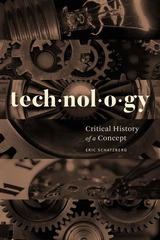 Technology: Critical History of a Concept
Eric Schatzberg
University of Chicago Press, 2018 In modern life, technology is everywhere. Yet as a concept, technology is a mess. In popular discourse, technology is little more than the latest digital innovations. Scholars do little better, offering up competing definitions that include everything from steelmaking to singing. In Technology: Critical History of a Concept, Eric Schatzberg explains why technology is so difficult to define by examining its three thousand year history, one shaped by persistent tensions between scholars and technical practitioners. Since the time of the ancient Greeks, scholars have tended to hold technicians in low esteem, defining technical practices as mere means toward ends defined by others. Technicians, in contrast, have repeatedly pushed back against this characterization, insisting on the dignity, creativity, and cultural worth of their work.
The tension between scholars and technicians continued from Aristotle through Francis Bacon and into the nineteenth century. It was only in the twentieth century that modern meanings of technology arose: technology as the industrial arts, technology as applied science, and technology as technique. Schatzberg traces these three meanings to the present day, when discourse about technology has become pervasive, but confusion among the three principal meanings of technology remains common. He shows that only through a humanistic concept of technology can we understand the complex human choices embedded in our modern world.
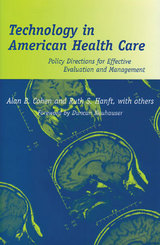 Technology in American Health Care: Policy Directions for Effective Evaluation and Management
Alan B. Cohen and Ruth S. Hanft, with William E. Encinosa, Stephanie M. Spernak, Shirley A. Stewart, and Catherine C. White
University of Michigan Press, 2004 "The definitive overview of health technology assessment in the U.S. and Europe, the biotech industry, adoption and use of medtech in health care."
---The World Future Society, Best Books and Reports
"This excellent book provides a broad overview of the development, impact, and evaluation of health technology in the United States. . . .The authors take a well-organized and thorough approach to address these topics, combining reviews of each with case examples of particular technologies. . . .Given the broad scope of the book, it could serve as a text for students, an introduction to the field for healthcare professionals, or a tool for academics and policymakers wishing to fill knowledge gaps outside their disciplines. . . .The book makes a compelling case for the logic and potential benefits of medical technology evaluation as a tool for improving health care."
---Journal of the American Medical Association
"By being comprehensive in their review, the authors chart a clear path to understanding the future of health care technology in America. They clarify the technical methods for evaluation and provide insight into the sociopolitical aspects of development and diffusion. Case studies are informative. Excellent reading for students and health professionals either as a textbook or as an off-the-shelf guide to methods for deciding among alternative technologies."
---Norman W. Weissman, University of Alabama
"Technology today dominates every aspect of health care. This useful book offers a diverse range of perspectives for students, professors, and medical practitioners who wish to understand how to evaluate medical technology."
---Joel Howell, University of Michigan Medical School
Technology in American Health Care is a comprehensive, multidisciplinary guide to understanding how medical advances-new drugs, biological devices, and surgical procedures-are developed, brought to market, evaluated, and adopted into health care.
Cost-effective delivery of evidence-based health care is the sine qua non of American medicine in the twenty-first century. Health care decision makers, providers, payers, policymakers, and consumers all need vital information about the risks, benefits, and costs of new technologies in order to make informed decisions about which ones to adopt and how to use them. Alan B. Cohen and Ruth S. Hanft explore the evolving field of medical technology evaluation (MTE), as well as the current controversies surrounding the evaluation and diffusion of medical technologies, including the methods employed in their assessment and the policies that govern their adoption and use.
The book opens with an introduction that provides basic definitions and the history of technological change in American medicine, and a second chapter that explores critical questions regarding medical technology in health care. Part I discusses biomedical innovation, the development and diffusion of medical technology, and the adoption and use of technology by hospitals, physicians, and other health care organizations and professions under changing health care market conditions. Part II examines the methods of MTE-including randomized controlled trials, meta-analyses, economic evaluation methods (such as cost-benefit, cost-effectiveness, and cost-utility analyses), and clinical decision analysis. Part III focuses on key public policy issues and concerns that affect the organization, financing, and delivery of health care and that relate importantly to medical technology, including safety, efficacy, quality, cost, access, equity, social, ethical, legal, and evaluation concerns. All three parts of the book provide a historical perspective on the relevant issues, methods, and policy concerns and contain examples of technologies whose development, adoption, evaluation, and use have contributed to our understanding of the field.
This book will be invaluable in making MTE more accessible to individuals who are directly involved in the evaluation process and those who are touched by it in their professional lives-policymakers, clinicians, managers, and researchers.
Technology in Russian Strategic Culture: From the Nineteenth Century to the Present Day
Anzhelika Solovyeva
Karolinum Press, 2024 A history of military-technological innovation in Russia.
This book traces the dynamics of military-technological innovation in Russia over the last hundred and fifty years, particularly focusing on three distinct periods: the introduction of rifled breech-loading weapons in Imperial Russia in the nineteenth century, the invention of nuclear weapons in the Soviet Union in the twentieth century, and the development of precision-guided weapons in post-Soviet Russia in the twenty-first century. The analysis relies extensively on primary data obtained from Russian archives, complemented by a series of expert interviews, and deciphers Russia’s distinct strategic cultural approach to military-technological innovation.
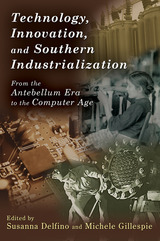 Technology, Innovation, and Southern Industrialization: From the Antebellum Era to the Computer Age
Edited by Susanna Delfino & Michele Gillespie
University of Missouri Press, 2008 Because of its strong agrarian roots, the South has typically been viewed as a region not favorably disposed to innovation and technology. Yet innovation was never absent from industrialization in this part of the United States. From the early nineteenth century onward, southerners were as eager as other Americans to embrace technology as a path to modernity. This volume features seven essays that range widely across the region and its history, from the antebellum era to the present, to assess the role of innovations presumed lacking by most historians. Offering a challenging interpretation of industrialization in the South, these writings show that the benefits of innovations had to be carefully weighed against the costs to both industry and society. The essays consider a wide range of innovative technologies. Some examine specific industries in subregions: steamboats in the lower Mississippi valley, textile manufacturing in Georgia and Arkansas, coal mining in Virginia, and sugar planting and processing in Louisiana. Others consider the role of technology in South Carolina textile mills around the turn of the twentieth century, the electrification of the Tennessee valley, and telemedicine in contemporary Arizona—marking the expansion of the region into the southwestern Sunbelt. Together, these articles show that southerners set significant limitations on what technological innovations they were willing to adopt, particularly in a milieu where slaveholding agriculture had shaped the allocation of resources. They also reveal how scarcity of capital and continued reliance on agriculture influenced that allocation into the twentieth century, relieved eventually by federal spending during the Depression and its aftermath that sparked the Sunbelt South’s economic boom. Technology, Innovation, and Southern Industrialization clearly demonstrates that the South’s embrace of technological innovation in the modern era doesn’t mark a radical change from the past but rather signals that such pursuits were always part of the region’s economy. It deflates the myth of southern agrarianism while expanding the scope of antebellum American industrialization beyond the Northeast and offers new insights into the relationship of southern economic history to the region’s society and politics.
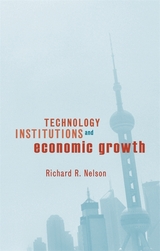 Technology, Institutions, and Economic Growth
Richard R. Nelson
Harvard University Press, 2005 This volume mounts a full-blown attack on the standard neo-classical theory of economic growth, which Richard Nelson sees as hopelessly inadequate to explain the phenomenon of economic growth. He presents an alternative theory which highlights that economic growth driven by technological advance involves disequilibrium in a fundamental and continuing way. Nelson also argues that a theory of economic growth driven by technological advance must recognize a range of institutions, such as universities, public laboratories, and government agencies, in addition to business firms and markets. He further argues that growth theories that focus on an aggregate measure of growth, such as GNP per capita, are blind to what is going on beneath the aggregate, where differing rates of advance in different sectors, and the birth and death of industries are an essential part of the growth process. The broad theory of economic growth Nelson presents sees the process as involving the co-evolution of technologies, institutions, and industry structure.
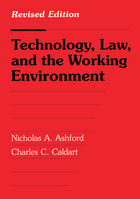 Technology, Law, and the Working Environment: Revised Edition
Nicholas A. Ashford and Charles C. Caldart
Island Press, 1996 Technology, Law, and the Working Environment provides a thorough discussion of the legal issues relevant to technology-related workplace problems. It includes detailed chapters that examine occupational health and safety, toxic substance regulations, technology bargaining, and the law as it applies to the work environment. The authors explore the scope of right-to-know requirements and other worker rights, and examine the legal consequences of injury and disease for both workers and firms.After discussing the evolution of technology, work, and health since the turn of the century, the authors explore the economic and political forces that spurred the development of a variety of legal responses.Among the topics considered are: costs of occupational disease and injury market alternatives to regulating health and safety the role of economic considerations in setting standards the usefulness of economic analysis in regulatory decisionmaking the relationship between environmental regulation and workplace regulation Throughout, the text is supplemented with excerpts from key judicial decisions and selected expert commentaries that provide valuable insights into how to use the law to best effect in the workplace.
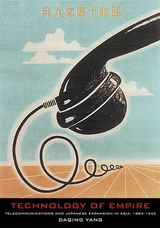 Technology of Empire: Telecommunications and Japanese Expansion in Asia, 1883–1945
Daqing Yang
Harvard University Press, 2010 Nearly half a century ago, the economic historian Harold Innis pointed out that the geographical limits of empires were determined by communications and that, historically, advances in the technologies of transport and communications have enabled empires to grow. This power of communications was demonstrated when Japanese Emperor Hirohito’s radio speech announcing Japan’s surrender and the dissolution of its empire was broadcast simultaneously throughout not only the Japanese home islands but also all the territories under its control over the telecommunications system that had, in part, made that empire possible.
In the extension of the Japanese empire in the 1930s and 1940s, technology, geo-strategy, and institutions were closely intertwined in empire building. The central argument of this study of the development of a communications network linking the far-flung parts of the Japanese imperium is that modern telecommunications not only served to connect these territories but, more important, made it possible for the Japanese to envision an integrated empire in Asia. Even as the imperial communications network served to foster integration and strengthened Japanese leadership and control, its creation and operation exacerbated long-standing tensions and created new conflicts within the government, the military, and society in general.
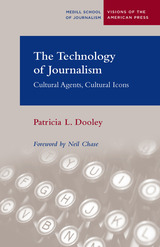 The Technology of Journalism: Cultural Agents, Cultural Icons
Patricia L. Dooley
Northwestern University Press, 2007 From the printing press to the telegraph to the camera and beyond, technology has always been tied closely to journalism. In The Technology of Journalism, Patricia L. Dooley proposes a history of news that heeds the social and cultural environments in which both technology and the press emerge and exist. By placing this history solidly in its cultural context, Dooley can explore the effects of shifts in social, economic, and political systems and the impact of war. One such development with far reaching implications was Matthew Brady’s use of photography during the Civil War. Growth or decline in readership can also influence technological changes in journalism; most recently, the shift toward digital and Web-based journalism has reshaped the press. Finally, Dooley assesses the legacy and future of print, deciding what happens to print journalism—and all forms of reportage—will depend on the willingness of industry leaders to innovate in ways that will help them connect, through their reporting, to Americans of all ages and walks of life.
The Technology of Transition: Science and Technology Policies for Transition Countries
David A. Dyker
Central European University Press, 1997 This book addresses the crucial question of how countries which have suffered losses in productivity levels and innovatory momentum over perhaps twenty-thirty years can rediscover their dynamism. Because the contributors have the immediate experience of tackling such complex problems and possess first-hand knowledge of a wide range of developmental patterns, each is well-placed to advise on the search for comprehensive solutions. The book not only focuses on the problems of innovation and technology transfer as they are reflected in the experience of the transition period to date, but also develops conceptual and strategic approaches to problems which will take a generation or more to resolve.
Technology, Pessimism, and Postmodernism
Yaron Ezrahi
University of Massachusetts Press, 1995 This collection of essays from international scholars from various disciplines addresses the theme of technological pessimism; the conviction that technology has given us the means not only to achieve unlimited progress, but to destroy ourselves and our most cherished values.
Technology, Productivity, and Economic Growth
Edited by Susanto Basu, Lucy Eldridge, John Haltiwanger, and Erich Strassner
University of Chicago Press, 2025 A wide-reaching exploration of how technological advancements influence and shape productivity and economic growth. Current technological developments in several industries, such as the rise of artificial intelligence and innovations associated with the green energy transition, are likely to have significant and wide-ranging effects. This volume explores the implications of rapid changes in advanced technology and considers how to conceptualize and model these advances and improve measures of productivity and economic growth. The study of these issues is facilitated both by new methods for using and integrating disparate data sources and by the availability of new data sources. The chapters in this volume leverage these developments to offer fresh insights into long-standing issues in productivity analysis and technological change.
 Technology's Pulse: Essays on Rhythm in German Modernism
Michael Cowan
University of London Press, 2011 , in particular, witnessed numerous efforts to define, discipline or 'liberate' temporal experience. Within this broader framework of thinking about temporality, 'rhythm' came to form the object of an intense and widespread preoccupation. Rhythmical research played a central role not only in the reconceptualisation of human physiology and labour in the late nineteenth century, but also in the emergence of a new leisure culture in the early twentieth. The book traces the ways in which notions of 'rhythm' were mobilised both to conceptualise modernity (narrate its origins and prescribe its directions) and, in particular, to forge a new understanding of temporal media that came to mark the mass-mediated experience of the 1920s: a conception of artistic media as mediators between the organic and the rational, the time of the body and that of the machine. Michael Cowan is Associate Professor of German and World Cinemas at McGill University. He is the author of Cult of the Will: Nervousness and German Modernity (2008), as well as several articles and collections on German literature, film, media and cultural history.
 Technomodern Poetics: The American Literary Avant-Garde at the Start of the Information Age
Todd F. Tietchen
University of Iowa Press, 2018 After the second World War, the term “technology” came to signify both the anxieties of possible annihilation in a rapidly changing world and the exhilaration of accelerating cultural change. Technomodern Poetics examines how some of the most well-known writers of the era described the tensions between technical, literary, and media cultures at the dawn of the Digital Age. Poets and writers such as Allen Ginsberg, Charles Olson, Jack Kerouac, and Frank O’Hara, among others, anthologized in Donald Allen’s iconic The New American Poetry, 1945–1960, provided a canon of work that has proven increasingly relevant to our technological present. Elaborating on the theories of contemporaneous technologists such as Norbert Wiener, Claude Shannon, J. C. R. Licklider, and a host of noteworthy others, these artists express the anxieties and avant-garde impulses they wrestled with as they came to terms with a complex array of issues raised by the dawning of the nuclear age, computer-based automation, and the expansive reach of electronic media. As author Todd Tietchen reveals, even as these writers were generating novel forms and concerns, they often continued to question whether such technological changes were inherently progressive or destructive. With an undeniable timeliness, Tietchen’s book is sure to appeal to courses in modern English literature and American studies, as well as among fans of Beat writers and early Cold War culture.
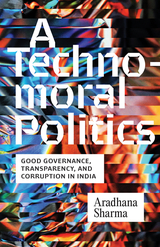 A Technomoral Politics: Good Governance, Transparency, and Corruption in India
Aradhana Sharma
University of Minnesota Press, 2024 Examining anticorruption battles and transparency laws to ask: what makes for good governance, and can it limit liberal democratic politics as much as encourage it?
Good governance is meant to empower citizens, increase democratic participation, and make states transparent and accountable, yet this liberal democratic imperative can also promote populist authoritarian rule. Bringing together discourses on ethical goodness with the technicalities of governance as expressed in laws and policies, Aradhana Sharma develops the concept of “technomoral politics” to navigate this fraught topic. With a focus on the work of activists, citizens, and state officials, she offers an ethnographic account of the contradictions and dangers of good-governance politics in twenty-first-century India. A Technomoral Politics follows the evolution of a group of activists in New Delhi led by Arvind Kejriwal from 2008 to 2014 as they morphed from a protransparency NGO to a mass movement against state corruption to a populist party that promised to change the political system through laws and policies. Sharma explores the technomoral framing of state opacity and corruption as well as the limits of the law in resolving these issues, probing such themes as the contradictory relationship between transparency and bureaucracy and the classed and gendered nature of democratic state institutions. By examining scalar dimensions of good-governance politics, from the hyperlocal work of activists to global trends, A Technomoral Politics illuminates the paradoxes, limits, and risks of a system that is meant to spread liberal democratic principles but that also ends up promoting antidemocratic, populist-authoritarian forms of rule. Retail e-book files for this title are screen-reader friendly.
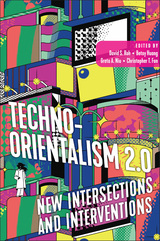 Techno-Orientalism 2.0: New Intersections and Interventions
David S. Roh
Rutgers University Press, 2025 Building on the groundbreaking Techno-Orientalism: Imagining Asia in Speculative Fiction, History, and Media, published by Rutgers University Press in 2015, Techno-Orientalism 2.0: New Intersections and Interventions addresses the impact of a volatile post-pandemic present on speculative futures by and about Asians. The backdrop of this highly anticipated follow-up is a world that is radically different than in 2015: COVID-19, threats of a “new cold war” with China, Russia’s invasion of Ukraine, and the reemergence of “strong man” politics around the world. An essential volume for this new critical juncture in Asian American history, Techno-Orientalism 2.0 catalogs intersectional dialogue with discourses such as Afrofuturism, Indigenous futurities, environmentalism, and disability studies. It also engages with recent high-profile and lesser-known works of Asian and Asian American speculative fiction, film, television, anime, art, music, journalism, architecture, state-sponsored policies and infrastructural projects, and the now-dominant China Panic.
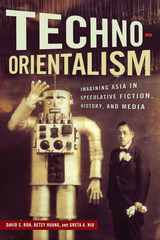 Techno-Orientalism: Imagining Asia in Speculative Fiction, History, and Media
Roh, David S.
Rutgers University Press, 2015 What will the future look like? To judge from many speculative fiction films and books, from Blade Runner to Cloud Atlas, the future will be full of cities that resemble Tokyo, Hong Kong, and Shanghai, and it will be populated mainly by cold, unfeeling citizens who act like robots. Techno-Orientalism investigates the phenomenon of imagining Asia and Asians in hypo- or hyper-technological terms in literary, cinematic, and new media representations, while critically examining the stereotype of Asians as both technologically advanced and intellectually primitive, in dire need of Western consciousness-raising. The collection’s fourteen original essays trace the discourse of techno-orientalism across a wide array of media, from radio serials to cyberpunk novels, from Sax Rohmer’s Dr. Fu Manchu to Firefly. Applying a variety of theoretical, historical, and interpretive approaches, the contributors consider techno-orientalism a truly global phenomenon. In part, they tackle the key question of how these stereotypes serve to both express and assuage Western anxieties about Asia’s growing cultural influence and economic dominance. Yet the book also examines artists who have appropriated techno-orientalist tropes in order to critique racist and imperialist attitudes. Techno-Orientalism is the first collection to define and critically analyze a phenomenon that pervades both science fiction and real-world news coverage of Asia. With essays on subjects ranging from wartime rhetoric of race and technology to science fiction by contemporary Asian American writers to the cultural implications of Korean gamers, this volume offers innovative perspectives and broadens conventional discussions in Asian American Cultural studies.
Technopharmacology
Joshua Neves
University of Minnesota Press, 2022 Exploring networked technologies and bioeconomy and their links to biotechnologies, pharmacology, and pharmaceuticals
Being on social media, having pornography or an internet addiction, consciousness hacking, and mundane smartness initiatives are practices embodied in a similar manner to the swallowing of a pill. Such close relations of media technologies to pharmaceuticals and pharmacology is the focus of this book. Technopharmacology is a modest call to expand media theoretical inquiry by attending to the biological, neurological, and pharmacological dimensions of media and centers on emergent affinities between big data and big pharma.
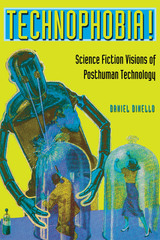 Technophobia!: Science Fiction Visions of Posthuman Technology
By Daniel Dinello
University of Texas Press, 2006 Techno-heaven or techno-hell? If you believe many scientists working in the emerging fields of twenty-first-century technology, the future is blissfully bright. Initially, human bodies will be perfected through genetic manipulation and the fusion of human and machine; later, human beings will completely shed the shackles of pain, disease, and even death, as human minds are downloaded into death-free robots whereby they can live forever in a heavenly "posthuman" existence. In this techno-utopian future, humanity will be saved by the godlike power of technology. If you believe the authors of science fiction, however, posthuman evolution marks the beginning of the end of human freedom, values, and identity. Our dark future will be dominated by mad scientists, rampaging robots, killer clones, and uncontrollable viruses. In this timely new book, Daniel Dinello examines "the dramatic conflict between the techno-utopia promised by real-world scientists and the techno-dystopia predicted by science fiction." Organized into chapters devoted to robotics, bionics, artificial intelligence, virtual reality, biotechnology, nanotechnology, and other significant scientific advancements, this book summarizes the current state of each technology, while presenting corresponding reactions in science fiction. Dinello draws on a rich range of material, including films, television, books, and computer games, and argues that science fiction functions as a valuable corrective to technological domination, countering techno-hype and reflecting the "weaponized, religiously rationalized, profit-fueled" motives of such science. By imaging a disastrous future of posthuman techno-totalitarianism, science fiction encourages us to construct ways to contain new technology, and asks its audience perhaps the most important question of the twenty-first century: is technology out of control?
TechnoRage: Poems
William Olsen
Northwestern University Press, 2017 William Olsen's TechnoRage is a meditative ode to nature. Its intensely lyrical poems remind us of our humanity, spinning free-ranging poetic conversations that question the ways of the world. In the age of the wide but often shallow lens of our new technology, Olsen takes a nod from Robert Frost and Gary Snyder, laying bare our need to return to the roots of things, where these poems find their voice. Olsen revels in language that is an intensely authentic rumination on our human isolation.
Technoscience, Volume 22
Patricia Ticineto Clough, ed.
Duke University Press This special issue of Social Text critically engages contemporary theory, shifting the question of "what matters" from an epistemological domain to an ontological one. Essays enter into debates over evolutionary theory and the potential effects of those debates on bodies and sexuality; examine South Asian racial formation, in which intense policing slides discipline into control, yet yields immeasurable "monstrous crossbreeds"; trace pharmaceutical governance in the control of AIDS in Brazil; and ask how political art commands or develops the capacity for attention, if not critique, in terms of the control exerted by dominant media cultures.
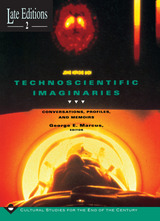 Technoscientific Imaginaries: Conversations, Profiles, and Memoirs
Edited by George E. Marcus
University of Chicago Press, 1995 What is it like to be a scientist at the end of the twentieth century? How have shifts in power and in assumptions about knowledge affected scientific practice? Who are the people behind the new technologies, and how do they address the difficult moral and professional issues during a time of global change? Techno-Scientific Imaginaries explores these and other important questions at the approach of the new millennium.
In these penetrating essays, twenty-four distinguished contributors from a broad range of fields present the voices of the scientists themselves—through interviews, conversations, and memoirs. We hear from Lithuanian physicists who discuss science after Communism and their own fantasies about what Western science is; a Japanese-American woman struggling with her ambivalence over designing nuclear weapons; political activists in India who examine relations among science, environmental politics, and government ideology in the aftermath of the Bhopal disaster; and many others, including biologists, physicians, corporate researchers, and scientists working with virtual reality and other cutting-edge technologies.
The contributors to this volume are Mario Biagioli, Maria E. Carson, Gary Lee Downey, Joseph Dumit, Michael M. J. Fischer, Mary-Jo DelVecchio Good, Hugh Gusterson, Diana L. L. Hill, James Holston, Herbert C. Hoover, Jr., Gudrun Klein, Leszek Koczanowicz, Irene Kuter, Kim Laughlin, Rita Linggood, George E. Marcus, Kathryn Milun, Livia Polanyi, Christopher Pound, Simon Powell, Paul Rabinow, Kathleen Stewart, Allucquere Rosanne Stone, and Sharon Traweek.
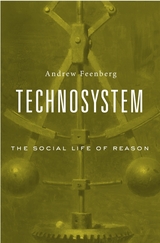 Technosystem: The Social Life of Reason
Andrew Feenberg
Harvard University Press, 2017 We live in a world of technical systems designed in accordance with technical disciplines and operated by personnel trained in those disciplines. This is a unique form of social organization that largely determines our way of life, but the actions of individuals and social protest still play a role in developing and purposing these rational systems. In Technosystem, Andrew Feenberg builds a theory of both the threats of technocratic modernity and the potential for democratic change.
Feenberg draws on the tradition of radical social criticism represented by Herbert Marcuse and the Frankfurt School, which recognized the social effects of instrumental rationality but did not advance a convincing alternative to the new forms of domination imposed by rational systems. That is where the fine-grained analyses of Science, Technology, and Society (STS) studies can contribute. Feenberg uses these approaches to reconcile the claims of rationality with the agency of a public increasingly mobilized to intervene in technically based decisions. The resulting social theory recognizes emerging forms of resistance, such as protests and hacking, as essential expressions of public life in the “rational society.”
Combining the most salient insights from critical theory with the empirical findings of STS, Technosystem advances the philosophical debate over the nature and practice of reason in modern society.
"Tecumseh" and Other Stories of the Ohio River Valley by Julia L. Dumont: Of The Ohio River Valley
Sandra Parker
University of Wisconsin Press, 2000 Julia Louisa Corry Dumont (1794–1857) was born in Marietta, Ohio. Heralded in her own day as the “first lady” of the Ohio River Valley, she wrote about the lives of ordinary pioneers and settlers when the area was still known as the West. Her early romantic style was typical of the era, depicting river boatmen and Native Americans like Tecumseh. Her stories represent village life and women’s plight as victims, as in her masterpiece Aunt Hetty.
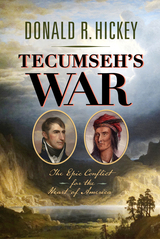 Tecumseh's War: The Epic Conflict for the Heart of America
Donald R. Hickey
Westholme Publishing, 2023 A Comprehensive History of the Most Important Native American Resistance Movement
The Shawnee leader Tecumseh came to prominence in a war against the United States waged from 1811 to 1815. In 1805, Tecumseh’s younger brother Lalawethika (soon to be known as “the Prophet”) had a vision for an Indian revitalization movement that would restore Native culture and resist American expansion. Tecumseh organized the growing support for this movement, which came from Indigenous peoples across the Old Northwest and parts of the Great Plains, into a loose but powerful military alliance.
In late 1811, while Tecumseh was away on a recruiting mission in the South, General William Henry Harrison led an army to the center of Native resistance at Prophetstown in present-day Indiana. In the early morning hours of November 7, in what came to be known as the Battle of Tippecanoe, Harrison’s men fought off an Indian attack, which marked the beginning of Tecumseh’s War. Seven months later, when the United States declared war on Britain, thus initiating the War of 1812, the British and Tecumseh forged an alliance against the United States. Initially, the Anglo-Indian alliance enjoyed considerable success at Detroit, Chicago, Mackinac, and elsewhere, exposing much of the Old Northwest to border warfare, but the tide turned in 1813 when Harrison invaded Canada. On October 5 the American army defeated a much smaller Anglo-Indian force in the climactic Battle of the Thames. Tecumseh was killed in this battle, and although his confederacy disintegrated, British support ensured that the Indian war would continue for another two years with the Sauk chief Black Hawk now providing the inspiration and leadership. Tecumseh’s War ended only in late 1815 after the British made peace with the United States and abandoned their native allies.
Tecumseh’s War: The Epic Conflict for the Heart of America is the first complete story of this major conflict. Distinguished historian Donald R. Hickey detaches it from the War of 1812, moving Tecumseh’s confederation to center stage to tell the sweeping and engrossing story of this last great Indian War—the last time that Indigenous Peoples had a powerful European ally to oppose United States expansion and thus the lastchance they had of shaping the future of the continent.
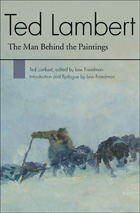 Ted Lambert: The Man Behind the Paintings
Ted Lambert
University of Alaska Press, 2012 Ted Lambert is regarded as one of the premier Alaska artists, a true pioneer. Born in 1905, and raised in the Chicago area, Lambert moved to Alaska in 1925 and went to work as a miner near McCarthy. He held several jobs, predominantly working at a copper mine and mushing dogs—first for adventure, and then as a mail carrier. Lambert left Alaska in 1931 to study art for a year at the American Academy of Art in Chicago, then moved to Seattle, where he began a mentorship under Eustace Ziegler, with whom he traveled throughout Alaska and painted. Eventually Lambert settled down in Fairbanks, where he stayed for twenty years and solidified his reputation as a painter and an artist. But in 1960 he disappeared from the remote cabin he was living in at Bristol Bay. No trace of his body was ever found, but among the effects rescued from his last home was a memoir of his early days in Alaska. Presented here and never before published, these memoirs reveal Lambert to be a keen and intelligent observer and relay the adventure story of a young man who would become one of Alaska’s most important artists.
 Teddy Roosevelt and Leonard Wood: Partners in Command
John S. D. Eisenhower
University of Missouri Press, 2013 Theodore Roosevelt was a man of wide interests, strong opinions, and intense ambition for both himself and his country. When he met Leonard Wood in 1897, he recognized a kindred spirit. Moreover, the two men shared a zeal for making the United States an imperial power that would challenge Great Britain as world leader. For the remainder of their lives, their careers would intertwine in ways that shaped the American nation. When the Spanish American War came, both men seized the opportunity to promote the goals of American empire. Roosevelt resigned as assistant secretary of the navy in William McKinley’s administration to serve as a lieutenant colonel of the Rough Riders, a newly organized volunteer cavalry. Wood, then a captain in the medical corps and physician to McKinley, was promoted to colonel and given charge of the unit. Roosevelt later took over command of the Rough Riders. In the Battle of San Juan Hill, he led it in a charge up Kettle Hill that would end in victory for the American troops and make their daring commander a household name, a war hero, and, eventually, president of the United States. At the Treaty of Paris in 1898, Spain ceded Cuba, Puerto Rico, Guam, and the Philippines to the United States. The next year, Wood became military governor of Cuba. He remained in the post until 1902. By that time Roosevelt was president. One of the major accomplishments of his administration was reorganization of the War Department, which the war with Spain had proved disastrously outdated. In 1909, when William Howard Taft needed a strong army chief of staff to enforce the new rules, he appointed Leonard Wood. Both Wood and Roosevelt were strong proponents of preparedness, and when war broke out in Europe in August 1914, Wood, retired as chief of staff and backed by Roosevelt, established the “Plattsburg camps,” a system of basic training camps. When America entered the Great War, the two men’s foresight was justified, but their earlier push for mobilization had angered Woodrow Wilson, and both were denied the command positions they sought in Europe. Roosevelt died in 1919 while preparing for another presidential campaign. Wood made a run in his place but was never taken seriously as a candidate. He retired from the army and spent the last seven years of his life as civilian governor of the Philippines. It was a quiet end for two men who had been giants of their time. While their modernization of the army is widely admired, they were not without their critics. Roosevelt and Wood saw themselves as bold leaders but were regarded by some as ruthless strivers. And while their shared ambitions for the United States were tempered by a strong sense of duty, they could, in their certainty and determination, trample those who stood in their path. Teddy Roosevelt and Leonard Wood: Partners in Command is a revealing and long overdue look at the dynamic partnership of this fascinating pair and will be welcomed by scholars and military history enthusiasts alike.
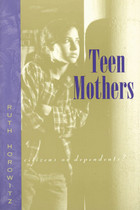 Teen Mothers--Citizens or Dependents?
Ruth Horowitz
University of Chicago Press, 1994 In a book that speaks clearly and forcefully to the heart of the welfare debate in the United States, Ruth Horowitz examines one of the most critical questions of welfare policy: how can a United States government program help teen mothers—one of the most needful groups of all welfare recipients—move from welfare dependency to employment, independence, and responsible citizenship?
"Rich vignettes reveal the complexities of teenage mothers' lives, particularly the disjuncture between classroom and street identities, 'inside' and 'outside.' . . . Original and illuminating as well as timely."—Sharon Thompson, Women's Review of Books
"Horowitz offers insights that should be considered in the debate over welfare reform. . . . Teen Mothers . . . places Horowitz's results in the context of major theories about the role of welfare in the U.S. and offers a microlevel critique of the implicit assumptions and probable consequences of each theory's approach to welfare reform."—Booklist
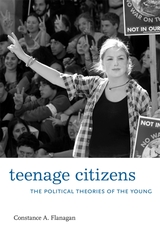 Teenage Citizens: The Political Theories of the Young
Constance A. Flanagan
Harvard University Press, 2013 Most teenagers are too young to vote and are off the radar of political scientists. Teenage Citizens looks beyond the electoral game to consider the question of how this overlooked segment of our citizenry understands political topics. Bridging psychology and political science, Constance Flanagan argues that civic identities form during adolescence and are rooted in teens’ everyday lives—in their experiences as members of schools and community-based organizations and in their exercise of voice, collective action, and responsibility in those settings. This is the phase of life when political ideas are born.
Through voices from a wide range of social classes and ethnic backgrounds in the United States and five other countries, we learn how teenagers form ideas about democracy, inequality, laws, ethnic identity, the social contract, and the ties that bind members of a polity together. Flanagan’s twenty-five years of research show how teens’ personal and family values accord with their political views. When their families emphasize social responsibility—for people in need and for the common good—and perform service to the community, teens’ ideas about democracy and the social contract highlight principles of tolerance, social inclusion, and equality. When families discount social responsibility relative to other values, teens’ ideas about democracy focus on their rights as individuals.
At a time when opportunities for youth are shrinking, Constance Flanagan helps us understand how young people come to envisage the world of politics and civic engagement, and how their own political identities take form.
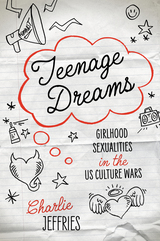 Teenage Dreams: Girlhood Sexualities in the U.S. Culture Wars
Charlie Jeffries
Rutgers University Press, 2022 Utilizing a breadth of archival sources from activists, artists, and policymakers, Teenage Dreams examines the race- and class-inflected battles over adolescent women’s sexual and reproductive lives in the late twentieth and early twenty-first century United States. Charlie Jeffries finds that most adults in this period hesitated to advocate for adolescent sexual and reproductive rights, revealing a new culture war altogether--one between adults of various political stripes in the cultural mainstream who prioritized the desire to delay girlhood sexual experience at all costs, and adults who remained culturally underground in their support for teenagers’ access to frank sexual information, and who would dare to advocate for this in public. The book tells the story of how the latter group of adults fought alongside teenagers themselves, who constituted a large and increasingly visible part of this activism. The history of the debates over teenage sexual behavior reveals unexpected alliances in American political battles, and sheds new light on the resurgence of the right in the US in recent years.
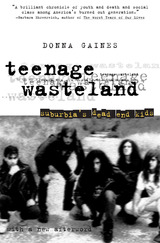 Teenage Wasteland: Suburbia's Dead End Kids
Donna Gaines
University of Chicago Press, 1998 Teenage Wasteland provides memorable portraits of "rock and roll kids" and shrewd analyses of their interests in heavy metal music and Satanism. A powerful indictment of the often manipulative media coverage of youth crises and so-called alternative programs designed to help "troubled" teens, Teenage Wasteland draws new conclusions and presents solid reasons to admire the resilience of suburbia's dead end kids.
"A powerful book."—Samuel G. Freedman, New York Times Book Review
"[Gaines] sheds light on a poorly understood world and raises compelling questions about what society might do to help this alienated group of young people."—Ann Grimes, Washington Post Book World
"There is no comparable study of teenage suburban culture . . . and very few ethnographic inquiries written with anything like Gaines's native gusto or her luminous eye for detail."—Andrew Ross, Transition
"An outstanding case study. . . . Gaines shows how teens engage in cultural production and how such social agency is affected by economic transformations and institutional interventions."—Richard Lachman, Contemporary Sociology
"The best book on contemporary youth culture."—Rolling Stone
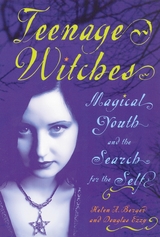 Teenage Witches: Magical Youth and the Search for the Self
Berger, Helen
Rutgers University Press, 2007 A popular new image of Witches has arisen in recent years, due largely to movies like The Craft, Practical Magic, and Simply Irresistible and television shows such as Buffy the Vampire Slayer, Sabrina the Teenage Witch, and Charmed. Here, young sexy Witches use magic and Witchcraft to gain control over their lives and fight evil. Then there is the depiction in the Harry Potter books: Witchcraft is a gift that unenlightened Muggles (everyday people) lack. In both types of portrayals, being a Witch is akin to being a superhero. At the other end of the spectrum, wary adults assume that Witches engage in evil practices that are misguided at best and dangerous at worst. Yet, as Helen A. Berger and Douglas Ezzy show in this in-depth look into the lives of teenage Witches, the reality of their practices, beliefs, values, and motivations is very different from the sensational depictions we see in popular culture. Drawing on extensive research across three countries--the United States, England, and Australia--and interviews with young people from diverse backgrounds, what they find are highly spiritual and self-reflective young men and women attempting to make sense of a postmodern world via a religion that celebrates the earth and emphasizes self-development. The authors trace the development of Neo-Paganism (an umbrella term used to distinguish earth-based religions from the pagan religions of ancient cultures) from its start in England during the 1940s, through its growing popularity in the decades that followed, up through its contemporary presence on the Internet. Though dispersed and disorganized, Neo-Pagan communities, virtual and real, are shown to be an important part of religious identity particularly for those seeking affirmation during the difficult years between childhood and adulthood.
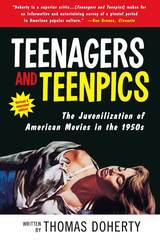 Teenagers And Teenpics: Juvenilization Of American Movies
Thomas Doherty
Temple University Press, 2002 Teenagers and Teenpics tells the story of two signature developments in the 1950s: the decline of the classical Hollywood cinema and the emergence of that strange new creature, the American teenager. Hollywood's discovery of the teenage moviegoer initiated a progressive "juvenilization" of film content that is today the operative reality of the American motion picture industry.The juvenilization of the American movies is best revealed in the development of the 1950s "teenpic," a picture targeted at teenagers even to the exclusion of their elders. In a wry and readable style, Doherty defines and interprets the various teenpic film types: rock 'n' roll pictures, j.d. films, horror and sci-fi weirdies, and clean teenpics. Individual films are examined both in light of their impact on the motion picture industry and in terms of their important role in validating the emerging teenage subculture. Also included in this edition is an expanded treatment of teenpics since the 1950s, especially the teenpics produced during the age of AIDS.
 Teens, Digital Media, and the Chicago Public Library
Penny Bender Sebring, Eric R. Brown, Kate M. Julian, Stacy B. Ehrlich, Susan E. Sporte, Erin Bradley, and Lisa Meyer
University of Chicago Press, 2013 As new initiatives to exploit technology and digital media for learning sweep the country, a learning center for teens at the Harold Washington Library in downtown Chicago demonstrates both the challenges and opportunities these efforts present, this report from the University of Chicago
Consortium on Chicago School Research finds.
The study:
-Illuminates how the design of YOUmedia shapes youth participation
-Describes the teens that YOUmedia serves, their patterns of participation, and the activities in which they engage
-Provides examples of the benefits youth perceive from their participation
-Characterizes the roles adults play in engaging teens and the ways programmatic choices have shifted
-Offers suggestions for organizations intending to launch similar initiatives
-Illustrates how YOUmedia instantiates elements of the emerging Connected Learning Model
Opened in the fall of 2009, YOUmedia Chicago, attempts to capitalize on teens’ interest in technology to motivate them to create, innovate and become active learners by providing them access to digital media, a safe, inviting space and staff members who serve as mentors. There currently are 30 learning centers across the country being modeled on YOUmedia Chicago and funded by the MacArthur Foundation and the Institute of Museum and Library Services.
Teeth
Aracelis Girmay
Northwestern University Press, 2007 Teeth is a stunning, highly original collection that celebrates the richness of the author's multicultural tradition. Girmay's poetry explores love, wars, wild hope, defiance, and the spirit of creativity with daring language and syntax. Behind this language, one senses a powerful, inventive woman who is not afraid to tackle any subject, including rape, genocide, and love, always sustained by an optimistic voice, assuring us that in the end justice will triumph and love will persevere.
LOVE,
you be the reason why
we swagger & jive,
lift the guitar, & pick up the axe.
when it is i tilt my hat to the side,
wearing colors & perfumes, it's cause, love,
you did it to me. oh,
you do sure turn my tongue to fiddle,
& make the salt taste sweet. man,
i don't need a rooster, or peacock even,
to help me spend my time, nope,
just you, love, right & solid as
a line.
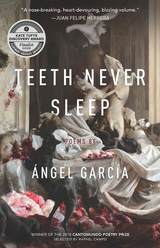 Teeth Never Sleep: Poems
Ángel García
University of Arkansas Press, 2018 Finalist, 2019 PEN Open Book Award Winner, 2019 American Book Award, Before Columbus Foundation Drawing on folklore and fantasy, childhood memory and hallucination, and marked by a tone of piercing divulgence, Teeth Never Sleep nimbly negotiates the split consciousness a culture of dominance requires of men (especially men of color), highlighting the fissures in selfhood created by the pressure to seek submission over intimacy while still wanting desperately to be loved, and tracing the contorted route by which emotional pain finds expression in violence. “The night my girlfriend tells my mother I beat her, / I feel betrayed. This was a secret we kept between us. / That night, I was no longer my mother’s loving son,” the speaker in one poem confesses, and later “I never wanted to be this kind of animal.” And yet, through the lens of Ángel García’s sharp imagining, men frequently appear as beasts (sometimes literally)—as hybrid beings both tender and brutal—that he steadfastly refuses to let off the hook as he obsessively catalogs the origins of toxic masculinity ( the first time I made my mother cry, the first time I pitied my father, the first time I saw a girl bleed) and its quiet, lasting effects: “Still a part of me believes a / man shouldn’t cry in front of a woman, even in the dark.” In a culture of weaponized masculinity, the poems in Teeth Never Sleep make a doorway of a wound, inviting readers to walk through and sit down inside the raw pain they harbor to meditate on two central, urgent questions: what it means to be a man and how, as a man, to love.
The Teeth of the Souls: A Novel
Steve Yates
Moon City, 2015 As the sequel to Morkan’s Quarry, The Teeth of the Souls tells the story of a marriage betrayed, a lifelong and secret love, and an Ozarks city riven by an Easter lynching.
The story begins just after the Civil War when Leighton Shea Morkan, son of Irish immigrants, marries Patricia Grünhaagen Weitzer, daughter of a German banking family. Yet he can’t let go of his childhood love and wartime confidante, the house hand and former slave, Judith. Both unions produce children, one a shrouded secret, and one the heir to the Morkan legacy: the limestone quarries of Springfield, Missouri, and the bloody past, what Judith calls “The Teeth of the Souls.”
Grounded in broad historical research and spanning Missouri’s reconstruction, vigilantism, and fall from grace, The Teeth of the Souls chronicles the violent melding of immigrant strains—Irish, German, Scots-Irish, and African American—into the fabric of the Ozarks.
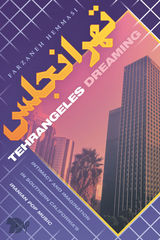 Tehrangeles Dreaming: Intimacy and Imagination in Southern California's Iranian Pop Music
Farzaneh Hemmasi
Duke University Press, 2020 Los Angeles, called Tehrangeles because it is home to the largest concentration of Iranians outside of Iran, is the birthplace of a distinctive form of postrevolutionary pop music. Created by professional musicians and media producers fleeing Iran's revolutionary-era ban on “immoral” popular music, Tehrangeles pop has been a part of daily life for Iranians at home and abroad for decades. In Tehrangeles Dreaming Farzaneh Hemmasi draws on ethnographic fieldwork in Los Angeles and musical and textual analysis to examine how the songs, music videos, and television made in Tehrangeles express modes of Iranianness not possible in Iran. Exploring Tehrangeles pop producers' complex commercial and political positioning and the histories, sensations, and fantasies their music makes available to global Iranian audiences, Hemmasi shows how unquestionably Iranian forms of Tehrangeles popular culture exemplify the manner in which culture, media, and diaspora combine to respond to the Iranian state and its political transformations. The transnational circulation of Tehrangeles culture, she contends, transgresses Iran's geographical, legal, and moral boundaries while allowing all Iranians the ability to imagine new forms of identity and belonging.
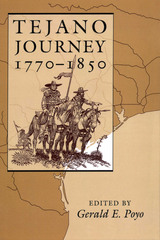 Tejano Journey, 1770-1850
Edited by Gerald E. Poyo
University of Texas Press, 1996 A century before the arrival of Stephen F. Austin's colonists, Spanish settlers from Mexico were putting down roots in Texas. From San Antonio de Bexar and La Bahia (Goliad) northeastward to Los Adaes and later Nacogdoches, they formed communities that evolved their own distinct "Tejano" identity. In Tejano Journey, 1770-1850, Gerald Poyo and other noted borderlands historians track the changes and continuities within Tejano communities during the years in which Texas passed from Spain to Mexico to the Republic of Texas and finally to the United States. The authors show how a complex process of accommodation and resistance—marked at different periods by Tejano insurrections, efforts to work within the political and legal systems, and isolation from the mainstream—characterized these years of changing sovereignty. While interest in Spanish and Mexican borderlands history has grown tremendously in recent years, the story has never been fully told from the Tejano perspective. This book complements and continues the history begun in Tejano Origins in Eighteenth-Century San Antonio, which Gerald E. Poyo edited with Gilberto M. Hinojosa.
Tejano Origins in Eighteenth-Century San Antonio
Edited by Gerald E. Poyo and Gilberto M. Hinojosa
University of Texas Press, 1991 Since its first publication in 1991, this history of early San Antonio has won a 1992 Citation from the San Antonio Conservation Society and a Presidio La Bahía Award from the Sons of the Republic of Texas.
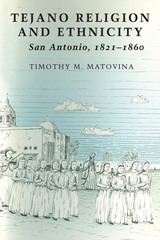 Tejano Religion and Ethnicity: San Antonio, 1821-1860
By Timothy M. Matovina
University of Texas Press, 1995 While the flags of Spain, Mexico, the Republic of Texas, and the United States successively flew over San Antonio, its Tejano community (Texans of Spanish or Mexican descent) formed a distinct ethnic identity that persisted despite rapid social and cultural changes. In this pioneering study, Timothy Matovina explores the central role of Tejano Catholicism in forging this unique identity and in binding the community together. The first book-length treatment of the historical role of religion in a Mexican-origin community in the United States, this study covers three distinct periods in the emergence of Tejano religious and ethnic identity: the Mexican period (1821-1836), the Texas Republic (1836-1845), and the first decade and a half after annexation into the United States (1845-1860). Matovina's research demonstrates how theories of unilateral assimilation are inadequate for understanding the Tejano community, especially in comparison with the experiences of European immigrants to the United States. As residents of the southwestern United States continue to sort out the legacy of U.S. territorial expansion in the nineteenth century, studies like this one offer crucial understanding of the survival and resilience of Latino cultures in the United States. Tejano Religion and Ethnicity will be of interest to a broad popular and scholarly audience.
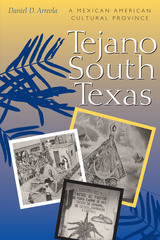 Tejano South Texas: A Mexican American Cultural Province
By Daniel D. Arreola
University of Texas Press, 2002 Winner, John Brinckerhoff Jackson Prize, Association of American Geographers On the plains between the San Antonio River and the Rio Grande lies the heartland of what is perhaps the largest ethnic region in the United States, Tejano South Texas. In this cultural geography, Daniel Arreola charts the many ways in which Texans of Mexican ancestry have established a cultural province in this Texas-Mexico borderland that is unlike any other Mexican American region. Arreola begins by delineating South Texas as an environmental and cultural region. He then explores who the Tejanos are, where in Mexico they originated, and how and where they settled historically in South Texas. Moving into the present, he examines many factors that make Tejano South Texas distinctive from other Mexican American regions—the physical spaces of ranchos, plazas, barrios, and colonias; the cultural life of the small towns and the cities of San Antonio and Laredo; and the foods, public celebrations, and political attitudes that characterize the region. Arreola's findings thus offer a new appreciation for the great cultural diversity that exists within the Mexican American borderlands.
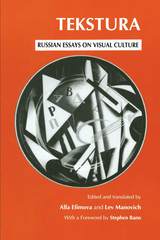 Tekstura: Russian Essays on Visual Culture
Edited by Alla Efimova and Lev Manovich
University of Chicago Press, 1993 Fascinated by the myth of the Russian avant-garde and scornful of official art, the West has been selective in its engagement with Russian visual culture. Yet how do contemporary Russian scholars and critics themselves approach the history of visual culture in the former Soviet Union?
Taking its title from a Russian word that can refer to the 'texture" of life, painting, or writing, this anthology assembles thirteen key essays in art history and cultural theory by Russian-language writers. The essays erase boundaries between high and low, official and dissident, avant-garde and socialist realism, art and everyday life. Everything visual is deemed worthy of analysis, whether painting or propaganda banners, architecture or candy wrappers, mass celebrations or urban refuse.
Most of the essays appear here in English for the first time. The editors have selected works of the past twenty years by philosophers, literary critics, film scholars, and art historians. Also included are influential earlier essays by Mikhail Bakhtin, V. N. Voloshinov, and Sergei Eisenstein. Compiled for general readers and specialists alike, Tekstura is a valuable resource for anyone interested in Russian and Soviet cultural history or in new theoretical approaches to the visual.
Tel Dan in Its Northern Cultic Context
Andrew R. Davis
SBL Press, 2013 This work presents in detail a description of archaeological data from the Iron II temple complex at Tel Dan in northern Israel. Davis analyzes the archaeological remains from the ninth and eighth centuries, paying close attention to how the temple functioned as sacred space. Correlating the archaeological data with biblical depictions of worship, especially the “textual strata” of 1 Kings 18 and the book of Amos, Davis argues that the temple was the site of “official” and family religion and that worship at the temple became increasingly centralized. Tel Dan's role in helping reconstruct ancient Israelite religion, especially distinctive religious traditions of the northern kingdom, is also considered.
Telecommunication Networks
J.E. Flood
The Institution of Engineering and Technology, 1997 Telecommunications is vital to modern life, and the global telecommunication network that has developed is an essential part of the infrastructure of society. Although there is an extensive literature on many aspects of telecommunication technology, comparatively little has been published on the functioning and planning of complete telecommunication networks. The first edition of this book was intended to help fill that gap and this new edition has been thoroughly revised and includes much new material.
Telecommunication Policy for the Information Age: From Monopoly to Competition
Gerald W. Brock
Harvard University Press, 1994 Gerald Brock develops a new theory of decentralized public decisionmaking and uses it to clarify the dramatic changes that have transformed the telecommunication industry from a heavily regulated monopoly to a set of market-oriented firms. He demonstrates how the decentralized decisionmaking process--whose apparent element of chaos has so often invited criticism--has actually made the United States a world leader in reforming telecommunication policy.
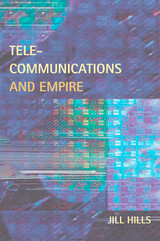 Telecommunications and Empire
Jill Hills
University of Illinois Press, 2007 Jill Hills picks up from her pathbreaking study The Struggle for Control of Global Communication: The Formative Century to continue her examination of the political, technological, and economic forces at work in the global telecommunications market from World War II to the World Trade Organization agreement of 1997. In the late twentieth century, focus shifted from the creation and development of global communication markets to their intense regulation. The historical framework behind this control--where the market was regulated, by what institution, controlled by what power, and to whose benefit--masterfully complements Hills's analysis of power relations within the global communications arena. Hills documents attempts by governments to direct, replace, and bypass international telecommunications institutions. As she shows, the results have offered indirect control over foreign domestic markets, government management of private corporations, and government protection of its own domestic communication market. Hills reveals that the motivation behind these powerful, regulatory efforts on person-to-person communication lies in the unmatched importance of communication in the world economy. As ownership of communications infrastructure becomes more valuable, governments have scrambled to shape international guidelines. Hills provides insight into struggles between U.S. policymakers and the rest of the world, illustrating the conflict between a growing telecommunications empire and sovereign states that are free to implement policy changes. Freshly detailing the interplay between U.S. federal regulation and economic power, Hills fosters a deep understanding of contemporary systems of power in global communications.
Telecommunications Network Modelling, Planning and Design
Sharon Evans
The Institution of Engineering and Technology, 2003 Telecommunications Network Modelling, Planning and Design addresses sophisticated modelling techniques from the perspective of the communications industry and covers some of the major issues facing telecommunications network engineers and managers today. Topics covered include network planning for transmission systems, modelling of SDH transport network structures and telecommunications network design and performance modelling, as well as network costs, ROI modelling and QoS in 3G networks. This practical book will prove a valuable resource to network engineers and managers working in today's competitive telecommunications environment.
Telecommunications Performance Engineering
Roger Ackerley
The Institution of Engineering and Technology, 2003 Service quality and cost control are critical success factors for the communications industry and performance engineering is vital in achieving both. It enables service quality to be 'built in' to products; cost control is achieved by addressing potential problems at an early stage, before the costs to remedy problems rise and large failure costs are incurred.
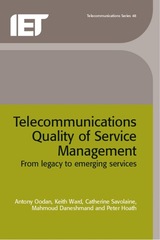 Telecommunications Quality of Service Management: From legacy to emerging services
Antony Oodan
The Institution of Engineering and Technology, 2003 In today's increasingly competitive communications environment, Quality of Service (QoS) is of paramount importance in the battle to win market share. However, the enhanced expectations of customers and the introduction of many new services and technologies makes comprehending and meeting customer requirements a real challenge. Building on the issues covered in Quality of Service in Telecommunications (1997), this book examines the technical, service and human issues that need to be addressed in order to provide a level of QoS that will meet those requirements. One key objective is to increase the reader's understanding of the importance of QoS and to show how the concepts presented can be applied to the reader's own circumstances. The book provides a comprehensive overview of definitions and standards, frameworks and models, network performance, internet, mobile and satellite services, the impact on customers, external drivers, economics, fraud and security and future trends. The authors, established experts in their fields, have wide-ranging experience in both UK and US telecommunications companies, reflecting the global nature of this industry and the universal concept of QoS.
Telecommunications Regulation
John Buckley
The Institution of Engineering and Technology, 2003 Telecommunications Regulation examines the background to regulation and the work of the regulator. It discusses typical regulatory rules and the legal and administrative framework for regulation, and looks at regulatory strategies, market structures and approaches to price control. The book includes a number of case studies which show how regulators engage with such topical issues as interconnection and loop unbundling, and also features technical coverage of both numbering and number portability. Finally, it looks at new products and services such as virtual network operators, intelligent networks, radio spectrum and next generation networks, and considers the impact these might have on the future of regulation.
Telecommunications Signalling
Richard Manterfield
The Institution of Engineering and Technology, 1999 As the Information Age evolves, customers need communications of high quality, excellent value and widespread mobility. The response is to establish efficient networks carrying a wide range of services. Signalling is at the heart of this revolution, energising networks to meet customer expectations.
 Telecommunications Traffic, Tariffs and Costs: An Introduction for Managers
R.E. Farr
The Institution of Engineering and Technology, 1988 This book has been written with the intention of helping those who ore concerned with planning, ordering, managing and using telecommunications facilities in connection with their business activities, and who do not wish to obtain a detailed technical and mathematical knowledge of the subject. The various types of telecommunications traffic are analysed without recourse to the underlying theory, and the reader is introduced to the terminology and operation of modern telecommunications systems and networks. Particular attention is paid to the relationship between traffic-carrying capacity and cost, and to the importance of traffic measurement and forecasting as a means of matching equipment provision to demand. The role of performance targets is discussed and the book explains how a comparison between public-network tariff options and the cost of private system and network alternatives can ensure a cost-effective solution to any communications problem. The principles are demonstrated by simple worked examples and a detailed glossary of terms is included.
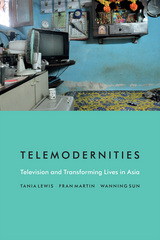 Telemodernities: Television and Transforming Lives in Asia
Tania Lewis, Fran Martin, and Wanning Sun
Duke University Press, 2016 Yoga gurus on lifestyle cable channels targeting time-pressured Indian urbanites; Chinese dating shows promoting competitive individualism; Taiwanese domestic makeover formats combining feng shui with life planning advice: Asian TV screens are increasingly home to a wild proliferation of popular factual programs providing lifestyle guidance to viewers. In Telemodernities Tania Lewis, Fran Martin, and Wanning Sun demonstrate how lifestyle-oriented popular factual television illuminates key aspects of late modernities in South and East Asia, offering insights not only into early twenty-first-century media cultures but also into wider developments in the nature of public and private life, identity, citizenship, and social engagement. Drawing on extensive interviews with television industry professionals and audiences across China, India, Taiwan, and Singapore, Telemodernities uses popular lifestyle television as a tool to help us understand emergent forms of identity, sociality, and capitalist modernity in Asia.
Telemorphosis
Jean Baudrillard
University of Minnesota Press, 2015 The art of living today has shifted to a continuous state of the experimental. In one of his last texts, Telemorphosis, renowned thinker and anti-philosopher Jean Baudrillard takes on the task of thinking and reflecting on the coming digital media architectures of the social. While “the social” may have never existed, according to Baudrillard, his analysis at the beginning of the twenty-first century of the coming social media–networked cultures cannot be ignored. One need not look far in order to find oneself snared within some sort of screenification of a techno-social community. “What the most radical critical critique, the most subversive delirious imagination, what no Situationist drift could have done . . . television has done.” Collective reality has entered a realm of telemorphosis.
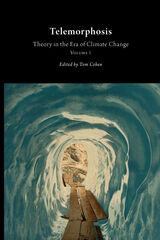 Telemorphosis: Theory in the Era of Climate Change
Tom Cohen
Michigan Publishing, 2012 This volume gathers notable critics and philosophers to engage the predominant impasse of an emerging era of climate change and ecocatastrophic acceleration: that is, how to conceptual and critical practices inherited from 20th century master-thinkers—who took no account of these emergences and logics—alter, adapt, mutate, or undergo translation at the current moment. Rather than assume that the humanities and philosophic practices of the past routed in the rethinking of language and power are suspended as irrelevant before mutations of the biosphere itself, Telemorphosis asks how, in fact, the latter have always been imbricated in these cognitive and linguistic practices and remain so, which is also to ask how a certain violence returns, today, to entirely different fields of reference. The writers in the volume ask, implicitly, how the 21st century horizons that exceed any political, economic, or conceptual models alters or redefines a series of key topoi. These range through figures of sexual difference, bioethics, care, species invasion, war, post-carbon thought, ecotechnics, time, and so on. As such, the volume is also a dossier on what metamorphoses await the legacies of “humanistic” thought in adapting to, or rethinking, the other materialities that impinge on contemporary “life as we know it.”
 The Teleology of Poetics in Medieval Kashmir
Lawrence J. McCrea
Harvard University Press This book examines the revolution in Sanskrit poetics initiated by the ninth-century Kashmiri Anandavardhana. Anandavardhana replaced the formalist aesthetic of earlier poeticians with one stressing the unifunctionality of literary texts, arguing that all components of a work should subserve a single purpose—the communication of a single emotional mood (rasa). Attention was redirected from formal elements toward specific poems, viewed as aesthetically integrated wholes, thereby creating new literary critical possibilities.
Anandavardhana’s model of textual coherence, along with many key analytic concepts, are rooted in the hermeneutic theory of the Mimamsakas (Vedic Exegetes). Like Anandavardhana, the Mimamsakas made the unifunctionality of texts their most basic interpretive principle.
While Anandavardhana’s teleological approach to textual analysis gained rapid acceptance among the Kashmiri poeticians, another aspect of his theory became controversial. He argued that rasa, and certain other poetic meanings, cannot be conveyed by recognized semantic processes, and therefore postulated a new semantic function, dhvani (“suggestion”) to account for them. The controversy over this “suggestion” rapidly became the central topic in poetics, to the exclusion of teleologically based criticism. While dhvani ultimately gained universal acceptance among Sanskrit poeticians, the conflict over its existence, ironically, marginalized Anandavardhana’s preferred approach to poetic analysis.
 Telepresence and Bio Art: Networking Humans, Rabbits and Robots
Eduardo Kac
University of Michigan Press, 2005 "Eduardo Kac's work represents a turning point. What it questions is our current attitudes to creativity, taking that word in its most fundamental sense."
-Edward Lucie-Smith, author of Visual Arts in the 20th Century
"His works introduce a vital new meaning into what had been known as the creative process while at the same time investing the notion of the artist-inventor with an original social and ethical responsibility."
-Frank Popper, author of Origins and Development of Kinetic Art
"Kac's radical approach to the creation and presentation of the body as a wet host for artificial memory and 'site-specific' work raises a variety of important questions that range from the status of memory in digital culture to the ethical dilemmas we are facing in the age of bioengineering and tracking technology."
-Christiane Paul, Whitney Museum of Art
For nearly two decades Eduardo Kac has been at the cutting edge of media art, first inventing early online artworks for the web and continuously developing new art forms that involve telecommunications and robotics as a new platform for art. Interest in telepresence, also known as telerobotics, exploded in the 1990s, and remains an important development in media art. Since that time, Kac has increasingly moved into the fields of biology and biotechnology.
Telepresence and Bio Art is the first book to document the evolution of bio art and the aesthetic development of Kac, the creator of the "artist's gene" as well as the controversial glow-in-the-dark, genetically engineered rabbit Alba. Kac covers a broad range of topics within media art, including telecommunications media, interactive systems and the Internet, telematics and robotics, and the contact between electronic art and biotechnology. Addressing emerging and complex topics, this book will be essential reading for anyone interested in contemporary art.
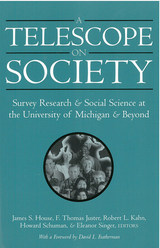 A Telescope on Society: Survey Research and Social Science at the University of Michigan and Beyond
James S. House, F. Thomas Juster, Robert L. Kahn, Howard Schuman, and Eleanor Singer, Editors
University of Michigan Press, 2004 A Telescope on Society seeks to convey the development of social science in the twentieth century through its interaction with a major new instrument for gathering data about society-survey research. The story of survey research and social science is largely told by social scientists affiliated with the Survey Research Center (SRC) and Institute for Social Research (IRS) at the University of Michigan about work done there. But the book also places this story in the broader context of survey-based social science in the United States and the world, to which many individuals and institutions beyond SRC, ISR, and Michigan have also contributed.
The chapters of this volume illustrate the impact that developments in survey research have had and continue to have on a broad range of social science disciplines and interdisciplinary areas ranging from political behavior and electoral systems to macroeconomics and individual income dynamics, mental and physical health, human development and aging, and racial/ethnic diversity and relationships.
The volume will speak to a wide audience of social science and survey research professionals and students interested in learning more about the broad history of survey-based social science and its contributions to understanding ourselves as social beings. It also seeks to convey how crucial institutional and public support are to the development of social science and survey research, as they have been to development in the natural, biomedical, and life sciences. The five editors of this book are longtime research professors and colleagues in the Survey Research Center of the Institute for Social Research at the University of Michigan. James S. House is also Professor in the Department of Sociology; F. Thomas Juster is Professor Emeritus in the Department of Economics; Robert L. Kahn is Professor Emeritus in the Department of Psychology and Department of Health Management and Policy; and Howard Schuman is Professor Emeritus in the Department of Sociology; Eleanor Singer is Research Professor in the Survey Research Center, all at the University of Michigan. Professors House (1991-2001), Kahn (1970-76), and Schuman (1982-90) have each served as Director of the Survey Research Center; Professor Juster served (1976-86) as Director of the Institute for Social Research; and Professor Singer served (1999-2002) as Associate Director of the Survey Research Center.
 Telescopes, Tides, and Tactics: A Galilean Dialogue about The Starry Messenger and Systems of the World
Stillman Drake
University of Chicago Press, 1983 Publication of Galileo's Starry Messenger in 1610, detailing startling observations with the newly invented telescope, sparked immediate furor among the astronomers and philosophers of the day. The discovery of the "Medicean stars" (the satellites of Jupiter) was pronounced a hoax, an optical illusion, a logical and theological impossibility. Stillman Drake, one of the world's foremost Galileo scholars, recreates in Telescopes, Tides, and Tactics the fascinating aftermath of the publication of the Starry Messenger. Drawing on Galileo's scientific working papers and the letters and notebooks of his colleagues, Drake presents an imaginative Galilean dialogue using the text of the Starry Messenger as a departure point for discussions of appropriate scientific method, new discoveries, and the emergence of a new world view at this early stage of the Scientific Revolution.
Drake has revised his earlier abridged translation of the Starry Messenger, and for the first time the entire work is presented here in modern English. No other edition or translation of this famous work has analyzed Galileo's recorded observations in detail, compared them with modern calculations, or explained the later use he made of them. In the accompanying fictional dialogue, Salviati, Sagredo, and Sarpi reread the Starry Messenger in 1613 and discuss events and issues raised in the three years since its publication. Much of the dialogue is based on archival materials not previously cited in English. Drake has unearthed a wealth of information that will interest the lay reader as well as the historian and the scientist—descriptions of the various and occasionally bizarre critics of Galileo, a reconstruction of Galileo's promised book on the system of the world, his tables of observations and calculations of satellite motions, and evidence for an early tide theory. It was this theory explaining tides by motions of the earth, rather than the influence of Platonic metaphysics, Drake argues that played a major role in Galileo's acceptance of Copernican astronomy.
Telescopes, Tides, and Tactics is a thorough portrait of Galileo as a working astronomer. Offering much more than a commentary on the Starry Messenger, Drake has written a novel and absorbing contribution to the history of physics and astronomy and the study of the Scientific Revolution.
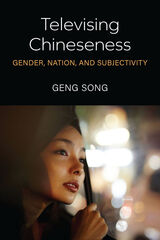 Televising Chineseness: Gender, Nation, and Subjectivity
Geng Song
University of Michigan Press, 2022 The serial narrative is one of the most robust and popular forms of storytelling in contemporary China. With a domestic audience of one billion-plus and growing transnational influence and accessibility, this form of storytelling is becoming the centerpiece of a fast-growing digital entertainment industry and a new symbol and carrier of China’s soft power. Televising Chineseness: Gender, Nation, and Subjectivity explores how television and online dramas imagine the Chinese nation and form postsocialist Chinese gendered subjects. The book addresses a conspicuous paradox in Chinese popular culture today: the coexistence of increasingly diverse gender presentations and conservative gender policing by the government, viewers, and society. Using first-hand data collected through interviews and focus group discussions with audiences comprising viewers of different ages, genders, and educational backgrounds, Televising Chineseness sheds light on how television culture relates to the power mechanisms and truth regimes that shape the understanding of gender and the construction of gendered subjects in postsocialist China.
Television, a memoir
Karen Brennan
Four Way Books, 2022 Television, a memoir is a hybrid collection of autobiographical pieces, tragi-comic in spirit, that depict a woman’s life evolving through time and culture in fragmentary glimpses. Indeterminate in genre, Television is a fluid text that sometimes reads as poetry, sometimes as prose, while exploring classism, ableism, and feminism in a world defined by the advent of new media and, for the author, a privilege that often felt suffocating. Working structurally and thematically, television creates conceptual mileposts in the memoir, with certain programs and cultural references corresponding to specific eras in the author’s past, but it also gestures at an existential modality — the experience of a televisual life, the performative arrangements of nuclear families and neighborhoods, the periodic events and dramas of an adolescence watched from outside oneself.
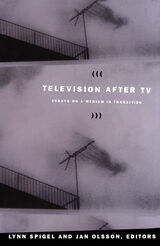 Television after TV: Essays on a Medium in Transition
Lynn Spigel and Jan Olsson, eds.
Duke University Press, 2004 In the last ten years, television has reinvented itself in numerous ways. The demise of the U.S. three-network system, the rise of multi-channel cable and global satellite delivery, changes in regulation policies and ownership rules, technological innovations in screen design, and the development of digital systems like TiVo have combined to transform the practice we call watching tv. If tv refers to the technologies, program forms, government policies, and practices of looking associated with the medium in its classic public service and three-network age, it appears that we are now entering a new phase of television. Exploring these changes, the essays in this collection consider the future of television in the United States and Europe and the scholarship and activism focused on it. With historical, critical, and speculative essays by some of the leading television and media scholars, Television after TV examines both commercial and public service traditions and evaluates their dual (and some say merging) fates in our global, digital culture of convergence. The essays explore a broad range of topics, including contemporary programming and advertising strategies, the use of television and the Internet among diasporic and minority populations, the innovations of new technologies like TiVo, the rise of program forms from reality tv to lifestyle programs, television’s changing role in public places and at home, the Internet’s use as a means of social activism, and television’s role in education and the arts. In dialogue with previous media theorists and historians, the contributors collectively rethink the goals of media scholarship, pointing toward new ways of accounting for television’s past, present, and future. Contributors. William Boddy, Charlotte Brunsdon, John T. Caldwell, Michael Curtin, Julie D’Acci, Anna Everett, Jostein Gripsrud, John Hartley, Anna McCarthy, David Morley, Jan Olsson, Priscilla Peña Ovalle, Lisa Parks, Jeffrey Sconce, Lynn Spigel, William Uricchio
Television: An international history of the formative years
R.W. Burns
The Institution of Engineering and Technology, 1998 From the first notions of 'seeing by electricity' in 1878, through the period of the first demonstration of rudimentary television in 1926 and up to 1940, when war brought the advance of the technology to a temporary halt, the development of television gathered about it a tremendous history. Following the discovery of the photo-conductive effect, numerous schemes for television were suggested but it was in the wake of Baird's early demonstrations that real industrial interest developed and the pace of progress increased. Much research and development work was undertaken in the UK, the US, Germany and France. By 1936 television technology had advanced to the point where high definition broadcasting was realistic.
Television and Criticism
Edited by Solange Davin and Rhona Jackson
Intellect Books, 2008 Television and Criticism unites distinguished scholars from the fields of literary criticism, media studies, and film studies to challenge the traditional boundaries between high and low culture. Through a theoretical lens, this volume addresses such topics as the blurring of genres, television and identity, and the sophistication of television audiences by examining examples from soap operas, televised adaptations of classic novels, film noir, and popular shows like Queer as Folk, Seinfeld, and Ally McBeal. Ranging from Shakespeare to Dragnet, this comprehensive study will interest cultural studies scholars and media buffs alike.
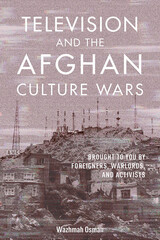 Television and the Afghan Culture Wars: Brought to You by Foreigners, Warlords, and Activists
Wazhmah Osman
University of Illinois Press, 2020 Portrayed in Western discourse as tribal and traditional, Afghans have in fact intensely debated women's rights, democracy, modernity, and Islam as part of their nation building in the post-9/11 era. Wazhmah Osman places television at the heart of these public and politically charged clashes while revealing how the medium also provides war-weary Afghans with a semblance of open discussion and healing. After four decades of gender and sectarian violence, she argues, the internationally funded media sector has the potential to bring about justice, national integration, and peace. Fieldwork from across Afghanistan allowed Osman to record the voices of many Afghan media producers and people. Afghans offer their own seldom-heard views on the country's cultural progress and belief systems, their understandings of themselves, and the role of international interventions. Osman analyzes the impact of transnational media and foreign funding while keeping the focus on local cultural contestations, productions, and social movements. As a result, she redirects the global dialogue about Afghanistan to Afghans and challenges top-down narratives of humanitarian development.
 Television Antiheroines: Women Behaving Badly in Crime and Prison Drama
Edited by Milly Buonanno
Intellect Books, 2017 As television has finally started to create more leading roles for women, the female antiheroine has emerged as a compelling and dynamic character type. Television Antiheroines looks closely at this recent development, exploring the emergence of women characters in roles typically reserved for men, particularly in the male-dominated genre of the crime and prison drama.
The essays collected in Television Antiheroines are divided into four sections or types of characters: mafia women, drug dealers and aberrant mothers, women in prison, and villainesses. Looking specifically at shows such as Gomorrah, Mafiosa, The Wire, The Sopranos, Sons of Anarchy, Orange is the New Black, and Antimafia Squad, the contributors explore the role of race and sexuality and focus on how many of the characters transgress traditional ideas about femininity and female identity, such as motherhood. They examine the ways in which bad women are portrayed and how these characters undermine gender expectations and reveal the current challenges by women to social and economic norms. Television Antiheroines will be essential reading for anyone with a serious interest in crime and prison drama and the rising prominence of women in nontraditional roles.
 Television as Digital Media
James Bennett and Niki Strange, eds.
Duke University Press, 2011 In Television as Digital Media, scholars from Australia, the United Kingdom, and the United States combine television studies with new media studies to analyze digital TV as part of digital culture. Taking into account technologies, industries, economies, aesthetics, and various production, user, and audience practices, the contributors develop a new critical paradigm for thinking about television, and the future of television studies, in the digital era. The collection brings together established and emerging scholars, producing an intergenerational dialogue that will be useful for anyone seeking to understand the relationship between television and digital media. Introducing the collection, James Bennett explains how television as digital media is a non-site-specific, hybrid cultural and technological form that spreads across platforms such as mobile phones, games consoles, iPods, and online video services, including YouTube, Hulu and the BBC’s iPlayer. Television as digital media threatens to upset assumptions about television as a mass medium that has helped define the social collective experience, the organization of everyday life, and forms of sociality. As often as we are promised the convenience of the television experience “anytime, anywhere,” we are invited to participate in communities, share television moments, and watch events live. The essays in this collection demonstrate the historical, production, aesthetic, and audience changes and continuities that underpin the emerging meaning of television as digital media. Contributors. James Bennett, William Boddy, Jean Burgess, John Caldwell, Daniel Chamberlain, Max Dawson, Jason Jacobs, Karen Lury, Roberta Pearson, Jeanette Steemers, Niki Strange, Julian Thomas, Graeme Turner
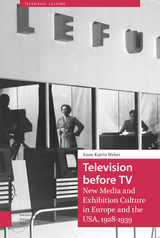 Television before TV: New Media and Exhibition Culture in Europe and the USA, 1928-1939
Anne-Katrin Weber
Amsterdam University Press, 2022 Television before TV rethinks the history of interwar television by exploring the medium’s numerous demonstrations organized at national fairs and international exhibitions in the late 1920s and 1930s. Building upon extensive archival research in Britain, Germany, and the United States, Anne-Katrin Weber analyses the sites where the new medium met its first audiences. She argues that public displays offered spaces where television's symbolic, cultural, political, and social definitions were negotiated and eventually stabilized; for the historian, the exhibitions therefore constitute crucial events to understand not only the medium's pre-war emergence, but also its subsequent domestication in the post-war years. Designed as a transnational study, her book highlights the multiple circulations of artefacts and ideas across borders of democratic and totalitarian regimes alike. Richly illustrated with 100 photographs, Television before TV finally emphasizes that even without regular programmes, interwar television was widely seen.
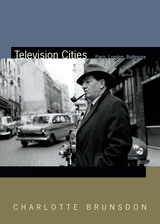 Television Cities: Paris, London, Baltimore
Charlotte Brunsdon
Duke University Press, 2018 In Television Cities Charlotte Brunsdon traces television's representations of metropolitan spaces to show how they reflect the medium's history and evolution, thereby challenging the prevalent assumptions about television as quintessentially suburban. Brunsdon shows how the BBC's presentation of 1960s Paris in the detective series Maigret signals British culture's engagement with twentieth-century modernity and continental Europe, while various portrayals of London—ranging from Dickens adaptations to the 1950s nostalgia of Call the Midwife—demonstrate Britain's complicated transition from Victorian metropole to postcolonial social democracy. Finally, an analysis of The Wire’s acclaimed examination of Baltimore, marks the profound shifts in the ways television is now made and consumed. Illuminating the myriad factors that make television cities, Brunsdon complicates our understanding of how television shapes perceptions of urban spaces, both familiar and unknown.
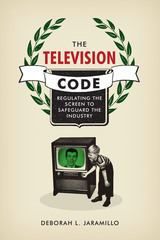 The Television Code: Regulating the Screen to Safeguard the Industry
By Deborah L. Jaramillo
University of Texas Press, 2018 The broadcasting industry’s trade association, the National Association of Broadcasters (NAB), sought to sanitize television content via its self-regulatory document, the Television Code. The Code covered everything from the stories, images, and sounds of TV programs (no profanity, illicit sex and drinking, negative portrayals of family life and law enforcement officials, or irreverence for God and religion) to the allowable number of commercial minutes per hour of programming. It mandated that broadcasters make time for religious programming and discouraged them from charging for it. And it called for tasteful and accurate coverage of news, public events, and controversial issues. Using archival documents from the Federal Communications Commission, NBC, the NAB, and a television reformer, Senator William Benton, this book explores the run-up to the adoption of the 1952 Television Code from the perspectives of the government, TV viewers, local broadcasters, national networks, and the industry’s trade association. Deborah L. Jaramillo analyzes the competing motives and agendas of each of these groups as she builds a convincing case that the NAB actually developed the Television Code to protect commercial television from reformers who wanted more educational programming, as well as from advocates of subscription television, an alternative distribution model to the commercial system. By agreeing to self-censor content that viewers, local stations, and politicians found objectionable, Jaramillo concludes, the NAB helped to ensure that commercial broadcast television would remain the dominant model for decades to come.
Television Courtroom Broadcasting: Distraction Effects and Eye-Tracking
Paul Lambert
Intellect Books, 2012 Are witnesses, jurors, or others in courtrooms distracted by in-court television cameras and their operators? Citing a lack of evidence one way or the other, the US Supreme Court has recommended additional research on the matter. Answering the court’s recommendation, this proof-of-concept study demonstrates for the first time that eye-tracking technology can now accurately determine whether courtroom actors look at the television cameras in the courtroom and for how long. In doing so, Television Courtroom Broadcasting opens the door to a new era of research on the effects of in-court distraction.
 Television Drama in Spain and Latin America: Genre and Format Translation
Paul Julian Smith
University of London Press, 2018 Customers in the USA and Canada ONLY can purchase the book from here: https://bit.ly/2nm5ZkR Television Drama in Spain and Latin America addresses two major topics within current cultural, media, and television studies: the question of fictional genres and that of transnational circulation. While much research has been carried out on both TV formats and remakes in the English-speaking world, almost nothing has been published on the huge and dynamic Spanish-speaking sector. This book discusses and analyses series since 2000 from Spain (in both Spanish and Catalan), Mexico, Venezuela, and (to a lesser extent) the US, employing both empirical research on production and distribution and textual analysis of content. The three genres examined are horror, biographical series, and sports-themed dramas; the three examples of format remakes are of a period mystery (Spain, Mexico), a romantic comedy (Venezuela, US), and a historical epic (Catalonia, Spain). Paul Julian Smith is Distinguished Professor at the Graduate Center, City University of New York. He was previously Professor of Spanish at the University of Cambridge. He is the author of twenty books and one hundred academic articles.
|
|


